Operations and Project Management
VerifiedAdded on 2023/06/18
|22
|5663
|416
AI Summary
This report discusses operations and project management principles in the context of Dyson, including continuous improvement plan and lean principles. It also analyzes the extent to which organizational operations management meets the requirements of the company.
Contribute Materials
Your contribution can guide someone’s learning journey. Share your
documents today.

Operations and Project
management
management
Secure Best Marks with AI Grader
Need help grading? Try our AI Grader for instant feedback on your assignments.
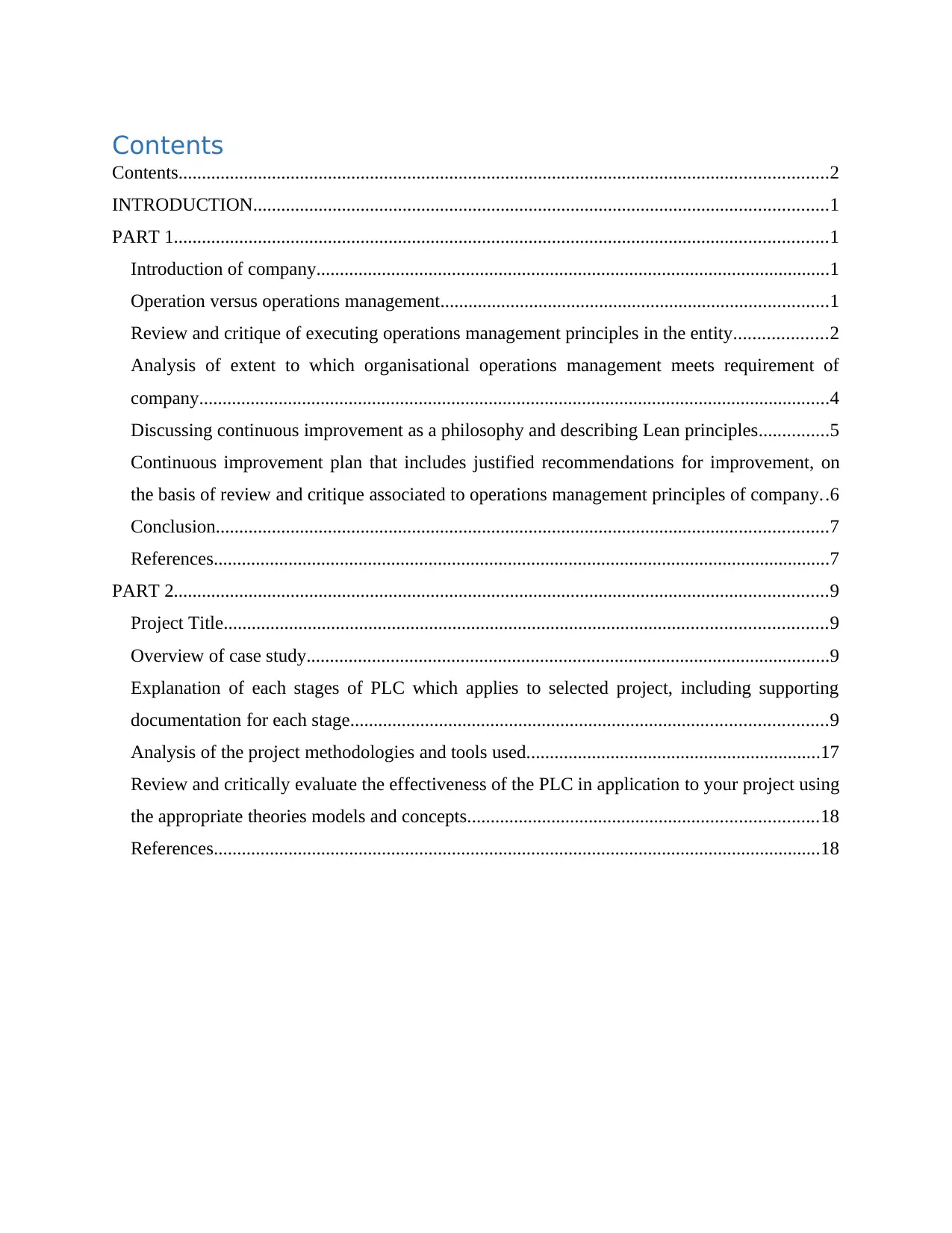
Contents
Contents...........................................................................................................................................2
INTRODUCTION...........................................................................................................................1
PART 1............................................................................................................................................1
Introduction of company..............................................................................................................1
Operation versus operations management...................................................................................1
Review and critique of executing operations management principles in the entity....................2
Analysis of extent to which organisational operations management meets requirement of
company.......................................................................................................................................4
Discussing continuous improvement as a philosophy and describing Lean principles...............5
Continuous improvement plan that includes justified recommendations for improvement, on
the basis of review and critique associated to operations management principles of company..6
Conclusion...................................................................................................................................7
References....................................................................................................................................7
PART 2............................................................................................................................................9
Project Title.................................................................................................................................9
Overview of case study................................................................................................................9
Explanation of each stages of PLC which applies to selected project, including supporting
documentation for each stage......................................................................................................9
Analysis of the project methodologies and tools used...............................................................17
Review and critically evaluate the effectiveness of the PLC in application to your project using
the appropriate theories models and concepts...........................................................................18
References..................................................................................................................................18
Contents...........................................................................................................................................2
INTRODUCTION...........................................................................................................................1
PART 1............................................................................................................................................1
Introduction of company..............................................................................................................1
Operation versus operations management...................................................................................1
Review and critique of executing operations management principles in the entity....................2
Analysis of extent to which organisational operations management meets requirement of
company.......................................................................................................................................4
Discussing continuous improvement as a philosophy and describing Lean principles...............5
Continuous improvement plan that includes justified recommendations for improvement, on
the basis of review and critique associated to operations management principles of company..6
Conclusion...................................................................................................................................7
References....................................................................................................................................7
PART 2............................................................................................................................................9
Project Title.................................................................................................................................9
Overview of case study................................................................................................................9
Explanation of each stages of PLC which applies to selected project, including supporting
documentation for each stage......................................................................................................9
Analysis of the project methodologies and tools used...............................................................17
Review and critically evaluate the effectiveness of the PLC in application to your project using
the appropriate theories models and concepts...........................................................................18
References..................................................................................................................................18

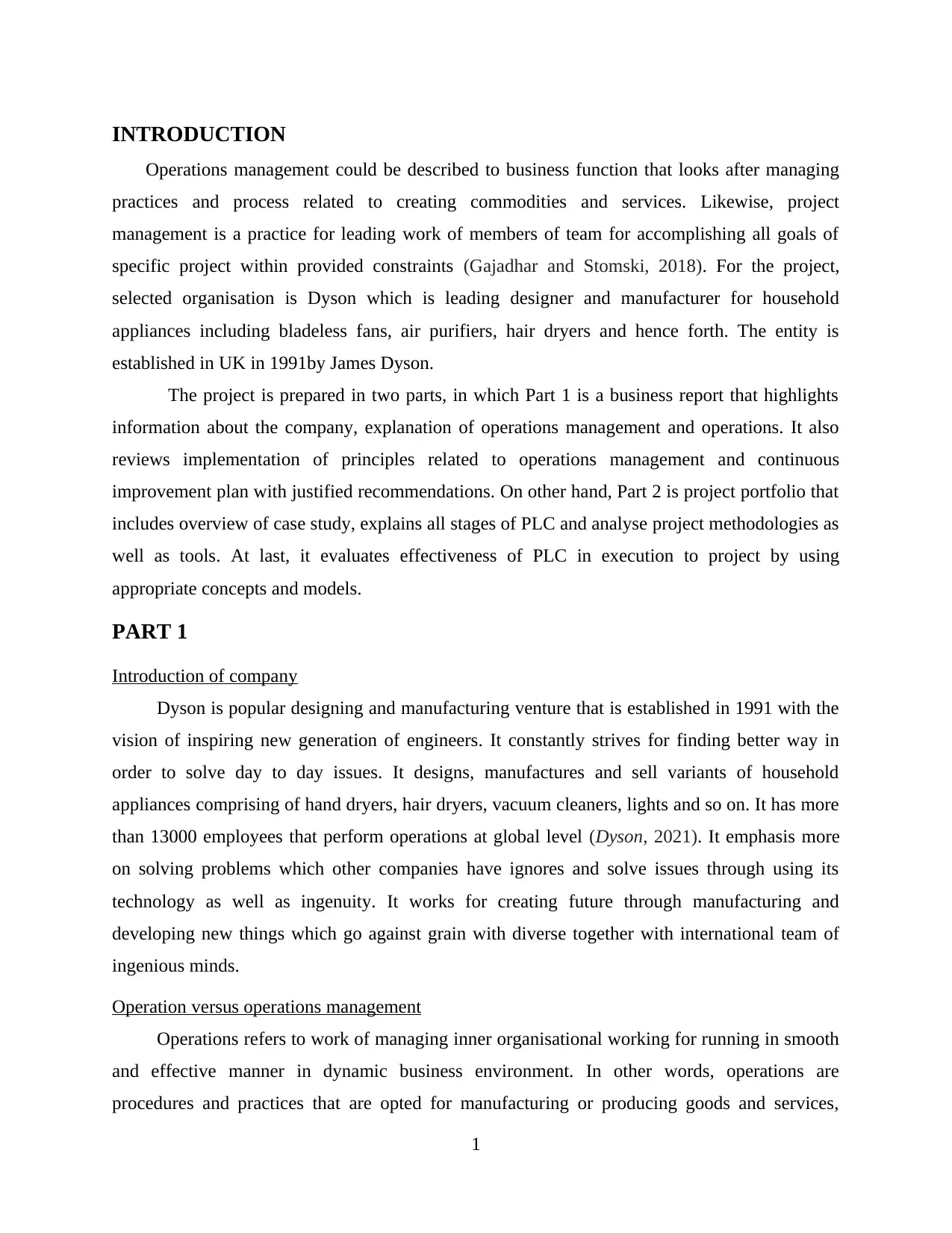
INTRODUCTION
Operations management could be described to business function that looks after managing
practices and process related to creating commodities and services. Likewise, project
management is a practice for leading work of members of team for accomplishing all goals of
specific project within provided constraints (Gajadhar and Stomski, 2018). For the project,
selected organisation is Dyson which is leading designer and manufacturer for household
appliances including bladeless fans, air purifiers, hair dryers and hence forth. The entity is
established in UK in 1991by James Dyson.
The project is prepared in two parts, in which Part 1 is a business report that highlights
information about the company, explanation of operations management and operations. It also
reviews implementation of principles related to operations management and continuous
improvement plan with justified recommendations. On other hand, Part 2 is project portfolio that
includes overview of case study, explains all stages of PLC and analyse project methodologies as
well as tools. At last, it evaluates effectiveness of PLC in execution to project by using
appropriate concepts and models.
PART 1
Introduction of company
Dyson is popular designing and manufacturing venture that is established in 1991 with the
vision of inspiring new generation of engineers. It constantly strives for finding better way in
order to solve day to day issues. It designs, manufactures and sell variants of household
appliances comprising of hand dryers, hair dryers, vacuum cleaners, lights and so on. It has more
than 13000 employees that perform operations at global level (Dyson, 2021). It emphasis more
on solving problems which other companies have ignores and solve issues through using its
technology as well as ingenuity. It works for creating future through manufacturing and
developing new things which go against grain with diverse together with international team of
ingenious minds.
Operation versus operations management
Operations refers to work of managing inner organisational working for running in smooth
and effective manner in dynamic business environment. In other words, operations are
procedures and practices that are opted for manufacturing or producing goods and services,
1
Operations management could be described to business function that looks after managing
practices and process related to creating commodities and services. Likewise, project
management is a practice for leading work of members of team for accomplishing all goals of
specific project within provided constraints (Gajadhar and Stomski, 2018). For the project,
selected organisation is Dyson which is leading designer and manufacturer for household
appliances including bladeless fans, air purifiers, hair dryers and hence forth. The entity is
established in UK in 1991by James Dyson.
The project is prepared in two parts, in which Part 1 is a business report that highlights
information about the company, explanation of operations management and operations. It also
reviews implementation of principles related to operations management and continuous
improvement plan with justified recommendations. On other hand, Part 2 is project portfolio that
includes overview of case study, explains all stages of PLC and analyse project methodologies as
well as tools. At last, it evaluates effectiveness of PLC in execution to project by using
appropriate concepts and models.
PART 1
Introduction of company
Dyson is popular designing and manufacturing venture that is established in 1991 with the
vision of inspiring new generation of engineers. It constantly strives for finding better way in
order to solve day to day issues. It designs, manufactures and sell variants of household
appliances comprising of hand dryers, hair dryers, vacuum cleaners, lights and so on. It has more
than 13000 employees that perform operations at global level (Dyson, 2021). It emphasis more
on solving problems which other companies have ignores and solve issues through using its
technology as well as ingenuity. It works for creating future through manufacturing and
developing new things which go against grain with diverse together with international team of
ingenious minds.
Operation versus operations management
Operations refers to work of managing inner organisational working for running in smooth
and effective manner in dynamic business environment. In other words, operations are
procedures and practices that are opted for manufacturing or producing goods and services,
1
Secure Best Marks with AI Grader
Need help grading? Try our AI Grader for instant feedback on your assignments.
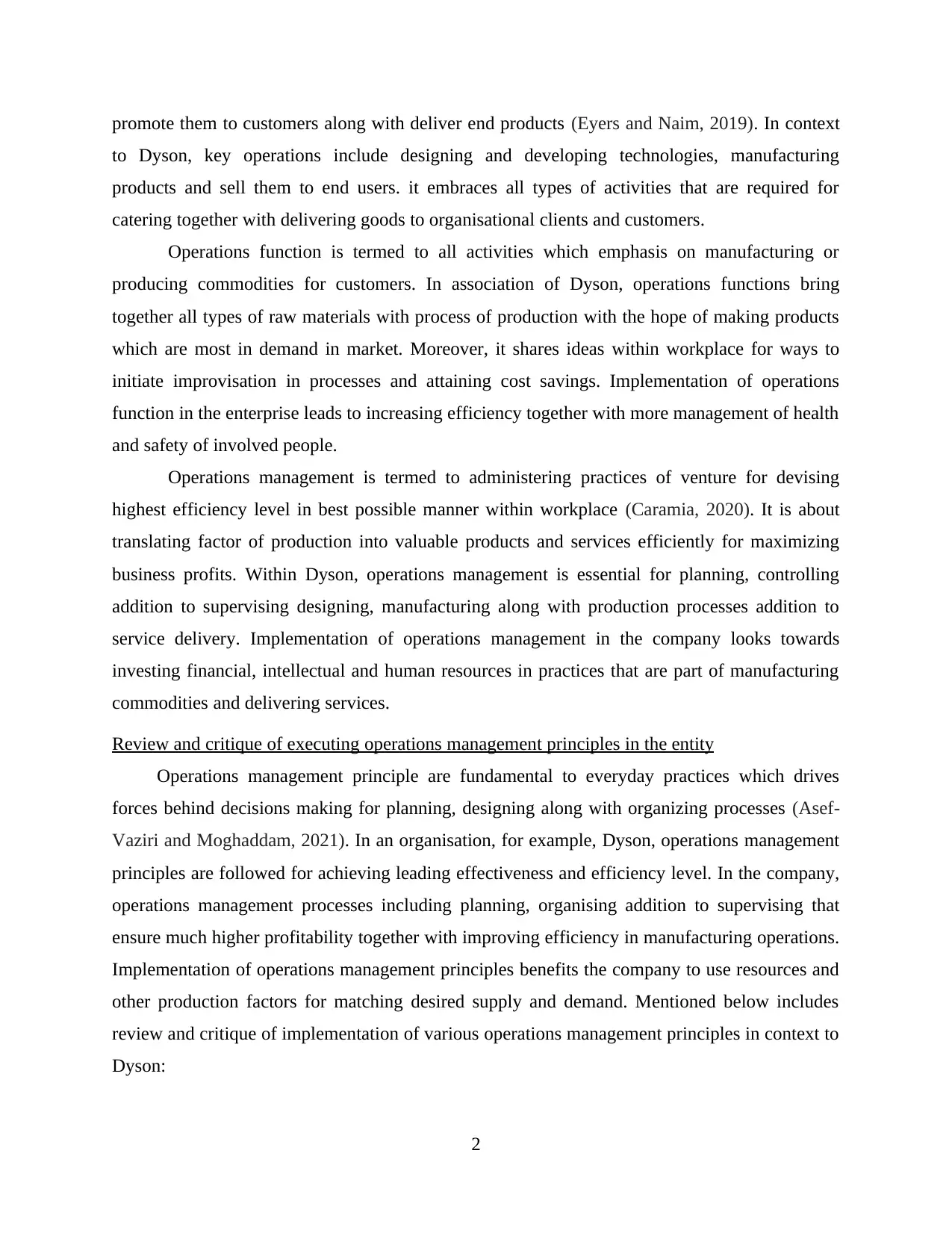
promote them to customers along with deliver end products (Eyers and Naim, 2019). In context
to Dyson, key operations include designing and developing technologies, manufacturing
products and sell them to end users. it embraces all types of activities that are required for
catering together with delivering goods to organisational clients and customers.
Operations function is termed to all activities which emphasis on manufacturing or
producing commodities for customers. In association of Dyson, operations functions bring
together all types of raw materials with process of production with the hope of making products
which are most in demand in market. Moreover, it shares ideas within workplace for ways to
initiate improvisation in processes and attaining cost savings. Implementation of operations
function in the enterprise leads to increasing efficiency together with more management of health
and safety of involved people.
Operations management is termed to administering practices of venture for devising
highest efficiency level in best possible manner within workplace (Caramia, 2020). It is about
translating factor of production into valuable products and services efficiently for maximizing
business profits. Within Dyson, operations management is essential for planning, controlling
addition to supervising designing, manufacturing along with production processes addition to
service delivery. Implementation of operations management in the company looks towards
investing financial, intellectual and human resources in practices that are part of manufacturing
commodities and delivering services.
Review and critique of executing operations management principles in the entity
Operations management principle are fundamental to everyday practices which drives
forces behind decisions making for planning, designing along with organizing processes (Asef-
Vaziri and Moghaddam, 2021). In an organisation, for example, Dyson, operations management
principles are followed for achieving leading effectiveness and efficiency level. In the company,
operations management processes including planning, organising addition to supervising that
ensure much higher profitability together with improving efficiency in manufacturing operations.
Implementation of operations management principles benefits the company to use resources and
other production factors for matching desired supply and demand. Mentioned below includes
review and critique of implementation of various operations management principles in context to
Dyson:
2
to Dyson, key operations include designing and developing technologies, manufacturing
products and sell them to end users. it embraces all types of activities that are required for
catering together with delivering goods to organisational clients and customers.
Operations function is termed to all activities which emphasis on manufacturing or
producing commodities for customers. In association of Dyson, operations functions bring
together all types of raw materials with process of production with the hope of making products
which are most in demand in market. Moreover, it shares ideas within workplace for ways to
initiate improvisation in processes and attaining cost savings. Implementation of operations
function in the enterprise leads to increasing efficiency together with more management of health
and safety of involved people.
Operations management is termed to administering practices of venture for devising
highest efficiency level in best possible manner within workplace (Caramia, 2020). It is about
translating factor of production into valuable products and services efficiently for maximizing
business profits. Within Dyson, operations management is essential for planning, controlling
addition to supervising designing, manufacturing along with production processes addition to
service delivery. Implementation of operations management in the company looks towards
investing financial, intellectual and human resources in practices that are part of manufacturing
commodities and delivering services.
Review and critique of executing operations management principles in the entity
Operations management principle are fundamental to everyday practices which drives
forces behind decisions making for planning, designing along with organizing processes (Asef-
Vaziri and Moghaddam, 2021). In an organisation, for example, Dyson, operations management
principles are followed for achieving leading effectiveness and efficiency level. In the company,
operations management processes including planning, organising addition to supervising that
ensure much higher profitability together with improving efficiency in manufacturing operations.
Implementation of operations management principles benefits the company to use resources and
other production factors for matching desired supply and demand. Mentioned below includes
review and critique of implementation of various operations management principles in context to
Dyson:
2
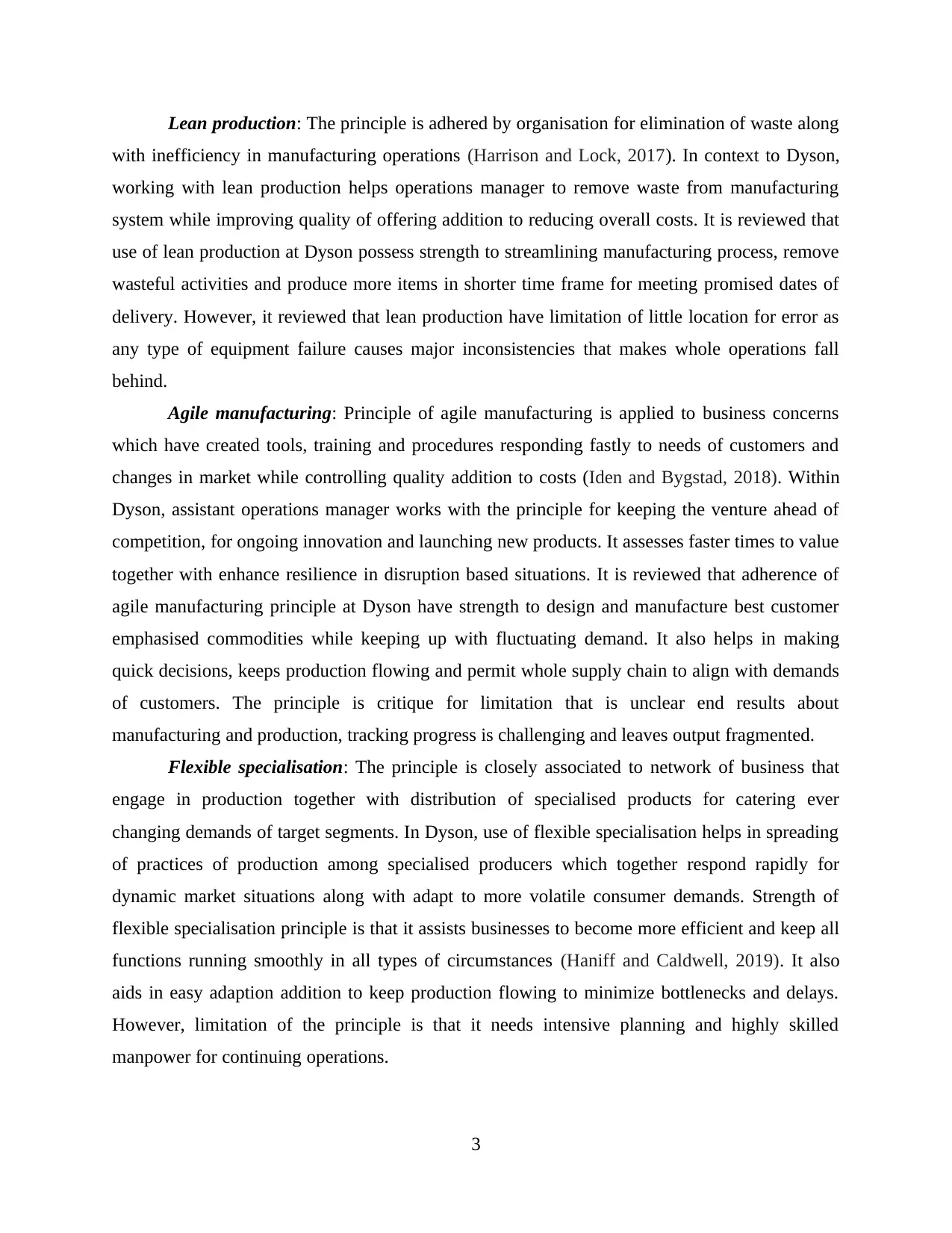
Lean production: The principle is adhered by organisation for elimination of waste along
with inefficiency in manufacturing operations (Harrison and Lock, 2017). In context to Dyson,
working with lean production helps operations manager to remove waste from manufacturing
system while improving quality of offering addition to reducing overall costs. It is reviewed that
use of lean production at Dyson possess strength to streamlining manufacturing process, remove
wasteful activities and produce more items in shorter time frame for meeting promised dates of
delivery. However, it reviewed that lean production have limitation of little location for error as
any type of equipment failure causes major inconsistencies that makes whole operations fall
behind.
Agile manufacturing: Principle of agile manufacturing is applied to business concerns
which have created tools, training and procedures responding fastly to needs of customers and
changes in market while controlling quality addition to costs (Iden and Bygstad, 2018). Within
Dyson, assistant operations manager works with the principle for keeping the venture ahead of
competition, for ongoing innovation and launching new products. It assesses faster times to value
together with enhance resilience in disruption based situations. It is reviewed that adherence of
agile manufacturing principle at Dyson have strength to design and manufacture best customer
emphasised commodities while keeping up with fluctuating demand. It also helps in making
quick decisions, keeps production flowing and permit whole supply chain to align with demands
of customers. The principle is critique for limitation that is unclear end results about
manufacturing and production, tracking progress is challenging and leaves output fragmented.
Flexible specialisation: The principle is closely associated to network of business that
engage in production together with distribution of specialised products for catering ever
changing demands of target segments. In Dyson, use of flexible specialisation helps in spreading
of practices of production among specialised producers which together respond rapidly for
dynamic market situations along with adapt to more volatile consumer demands. Strength of
flexible specialisation principle is that it assists businesses to become more efficient and keep all
functions running smoothly in all types of circumstances (Haniff and Caldwell, 2019). It also
aids in easy adaption addition to keep production flowing to minimize bottlenecks and delays.
However, limitation of the principle is that it needs intensive planning and highly skilled
manpower for continuing operations.
3
with inefficiency in manufacturing operations (Harrison and Lock, 2017). In context to Dyson,
working with lean production helps operations manager to remove waste from manufacturing
system while improving quality of offering addition to reducing overall costs. It is reviewed that
use of lean production at Dyson possess strength to streamlining manufacturing process, remove
wasteful activities and produce more items in shorter time frame for meeting promised dates of
delivery. However, it reviewed that lean production have limitation of little location for error as
any type of equipment failure causes major inconsistencies that makes whole operations fall
behind.
Agile manufacturing: Principle of agile manufacturing is applied to business concerns
which have created tools, training and procedures responding fastly to needs of customers and
changes in market while controlling quality addition to costs (Iden and Bygstad, 2018). Within
Dyson, assistant operations manager works with the principle for keeping the venture ahead of
competition, for ongoing innovation and launching new products. It assesses faster times to value
together with enhance resilience in disruption based situations. It is reviewed that adherence of
agile manufacturing principle at Dyson have strength to design and manufacture best customer
emphasised commodities while keeping up with fluctuating demand. It also helps in making
quick decisions, keeps production flowing and permit whole supply chain to align with demands
of customers. The principle is critique for limitation that is unclear end results about
manufacturing and production, tracking progress is challenging and leaves output fragmented.
Flexible specialisation: The principle is closely associated to network of business that
engage in production together with distribution of specialised products for catering ever
changing demands of target segments. In Dyson, use of flexible specialisation helps in spreading
of practices of production among specialised producers which together respond rapidly for
dynamic market situations along with adapt to more volatile consumer demands. Strength of
flexible specialisation principle is that it assists businesses to become more efficient and keep all
functions running smoothly in all types of circumstances (Haniff and Caldwell, 2019). It also
aids in easy adaption addition to keep production flowing to minimize bottlenecks and delays.
However, limitation of the principle is that it needs intensive planning and highly skilled
manpower for continuing operations.
3
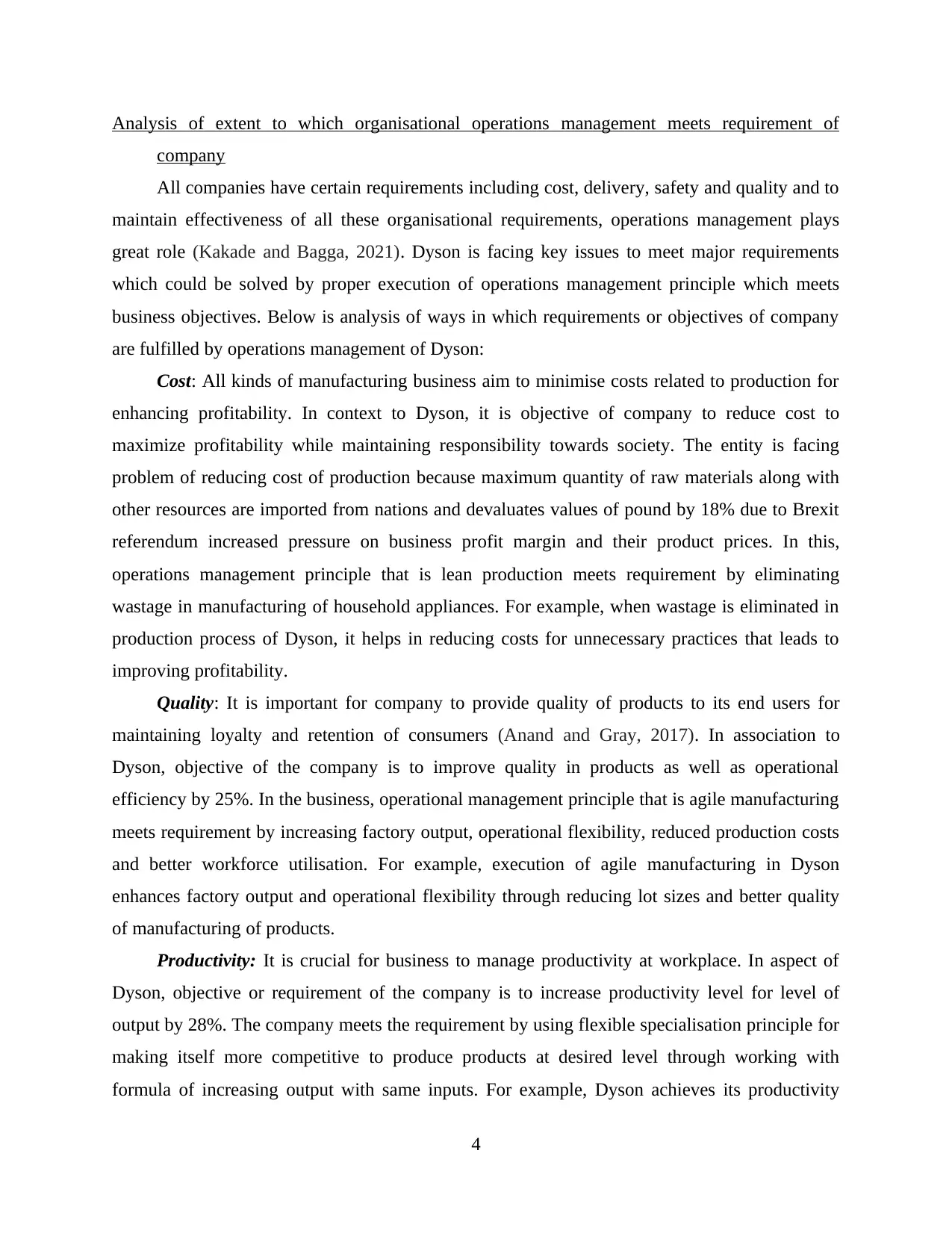
Analysis of extent to which organisational operations management meets requirement of
company
All companies have certain requirements including cost, delivery, safety and quality and to
maintain effectiveness of all these organisational requirements, operations management plays
great role (Kakade and Bagga, 2021). Dyson is facing key issues to meet major requirements
which could be solved by proper execution of operations management principle which meets
business objectives. Below is analysis of ways in which requirements or objectives of company
are fulfilled by operations management of Dyson:
Cost: All kinds of manufacturing business aim to minimise costs related to production for
enhancing profitability. In context to Dyson, it is objective of company to reduce cost to
maximize profitability while maintaining responsibility towards society. The entity is facing
problem of reducing cost of production because maximum quantity of raw materials along with
other resources are imported from nations and devaluates values of pound by 18% due to Brexit
referendum increased pressure on business profit margin and their product prices. In this,
operations management principle that is lean production meets requirement by eliminating
wastage in manufacturing of household appliances. For example, when wastage is eliminated in
production process of Dyson, it helps in reducing costs for unnecessary practices that leads to
improving profitability.
Quality: It is important for company to provide quality of products to its end users for
maintaining loyalty and retention of consumers (Anand and Gray, 2017). In association to
Dyson, objective of the company is to improve quality in products as well as operational
efficiency by 25%. In the business, operational management principle that is agile manufacturing
meets requirement by increasing factory output, operational flexibility, reduced production costs
and better workforce utilisation. For example, execution of agile manufacturing in Dyson
enhances factory output and operational flexibility through reducing lot sizes and better quality
of manufacturing of products.
Productivity: It is crucial for business to manage productivity at workplace. In aspect of
Dyson, objective or requirement of the company is to increase productivity level for level of
output by 28%. The company meets the requirement by using flexible specialisation principle for
making itself more competitive to produce products at desired level through working with
formula of increasing output with same inputs. For example, Dyson achieves its productivity
4
company
All companies have certain requirements including cost, delivery, safety and quality and to
maintain effectiveness of all these organisational requirements, operations management plays
great role (Kakade and Bagga, 2021). Dyson is facing key issues to meet major requirements
which could be solved by proper execution of operations management principle which meets
business objectives. Below is analysis of ways in which requirements or objectives of company
are fulfilled by operations management of Dyson:
Cost: All kinds of manufacturing business aim to minimise costs related to production for
enhancing profitability. In context to Dyson, it is objective of company to reduce cost to
maximize profitability while maintaining responsibility towards society. The entity is facing
problem of reducing cost of production because maximum quantity of raw materials along with
other resources are imported from nations and devaluates values of pound by 18% due to Brexit
referendum increased pressure on business profit margin and their product prices. In this,
operations management principle that is lean production meets requirement by eliminating
wastage in manufacturing of household appliances. For example, when wastage is eliminated in
production process of Dyson, it helps in reducing costs for unnecessary practices that leads to
improving profitability.
Quality: It is important for company to provide quality of products to its end users for
maintaining loyalty and retention of consumers (Anand and Gray, 2017). In association to
Dyson, objective of the company is to improve quality in products as well as operational
efficiency by 25%. In the business, operational management principle that is agile manufacturing
meets requirement by increasing factory output, operational flexibility, reduced production costs
and better workforce utilisation. For example, execution of agile manufacturing in Dyson
enhances factory output and operational flexibility through reducing lot sizes and better quality
of manufacturing of products.
Productivity: It is crucial for business to manage productivity at workplace. In aspect of
Dyson, objective or requirement of the company is to increase productivity level for level of
output by 28%. The company meets the requirement by using flexible specialisation principle for
making itself more competitive to produce products at desired level through working with
formula of increasing output with same inputs. For example, Dyson achieves its productivity
4
Paraphrase This Document
Need a fresh take? Get an instant paraphrase of this document with our AI Paraphraser

objective by emphasizing high priority tasks, minimizing distractions and managing ratio among
volume of inputs to that of outputs.
Discussing continuous improvement as a philosophy and describing Lean principles
Continuous improvement is ongoing developments in commodities, services and processes
with the help of incremental as well as breakthrough improvement methods (Kimmons and
Loweree, 2017). Within Dyson, purpose of continuous improvement is to improve all aspects of
organisational process through emphasizing on practices which generate most values for
customers while eliminating waste activities in possible manner. Philosophy of continuous
improvements states that business manager carries out efforts for improving performance of
offerings with the hope of attaining customer satisfaction.
Lean production is described to a management approach which looks after cutting out
waste and ensures quality. In all business aspects such as designing, production, distribution and
hence forth, lean principle is applied. It cut costs through making venture more responsive along
with efficient to market needs. In context to Dyson, lean principle is used for improving quality
of products, reducing manufacturing times, eliminating unnecessary waste as well as decreasing
total costs. Some methods related to lean production that are applied in Dyson are as follows:
Kaizen: It is said to a strategy of entity in which staff members work together proactively
in order to achieve incremental addition to regular improvements in process of manufacturing
(Essila, 2019). In Dyson, usage of Kaizen is effective as it emphasizes towards collective
resources along with talents on creating culture continually on lookout for aspects to eliminate
waste in manufacturing of appliances.
Just in time (JIT): It is methods of lean production which eliminates waste of excessive
stock or inventory. Within Dyson, operations manager uses just in time method to reduce time of
flow in production systems and response times from suppliers to customers. It is effective
methodology because it prevents over production, decrease product defects, reduce capital that is
tied up in inventory, dispense with requirement for inventory operations, saves resources through
streamlining production systems, minimise transport costs and waiting time.
Simultaneous engineering: It is about designing and developing commodities wherein
distinct phases run simultaneously despite of consecutively (Marsh and McCannell, 2017). The
method decreases product development time and time to market that that results in reduced costs
addition to improved productivity. In Dyson, application of simultaneous engineering is effective
5
volume of inputs to that of outputs.
Discussing continuous improvement as a philosophy and describing Lean principles
Continuous improvement is ongoing developments in commodities, services and processes
with the help of incremental as well as breakthrough improvement methods (Kimmons and
Loweree, 2017). Within Dyson, purpose of continuous improvement is to improve all aspects of
organisational process through emphasizing on practices which generate most values for
customers while eliminating waste activities in possible manner. Philosophy of continuous
improvements states that business manager carries out efforts for improving performance of
offerings with the hope of attaining customer satisfaction.
Lean production is described to a management approach which looks after cutting out
waste and ensures quality. In all business aspects such as designing, production, distribution and
hence forth, lean principle is applied. It cut costs through making venture more responsive along
with efficient to market needs. In context to Dyson, lean principle is used for improving quality
of products, reducing manufacturing times, eliminating unnecessary waste as well as decreasing
total costs. Some methods related to lean production that are applied in Dyson are as follows:
Kaizen: It is said to a strategy of entity in which staff members work together proactively
in order to achieve incremental addition to regular improvements in process of manufacturing
(Essila, 2019). In Dyson, usage of Kaizen is effective as it emphasizes towards collective
resources along with talents on creating culture continually on lookout for aspects to eliminate
waste in manufacturing of appliances.
Just in time (JIT): It is methods of lean production which eliminates waste of excessive
stock or inventory. Within Dyson, operations manager uses just in time method to reduce time of
flow in production systems and response times from suppliers to customers. It is effective
methodology because it prevents over production, decrease product defects, reduce capital that is
tied up in inventory, dispense with requirement for inventory operations, saves resources through
streamlining production systems, minimise transport costs and waiting time.
Simultaneous engineering: It is about designing and developing commodities wherein
distinct phases run simultaneously despite of consecutively (Marsh and McCannell, 2017). The
method decreases product development time and time to market that that results in reduced costs
addition to improved productivity. In Dyson, application of simultaneous engineering is effective
5
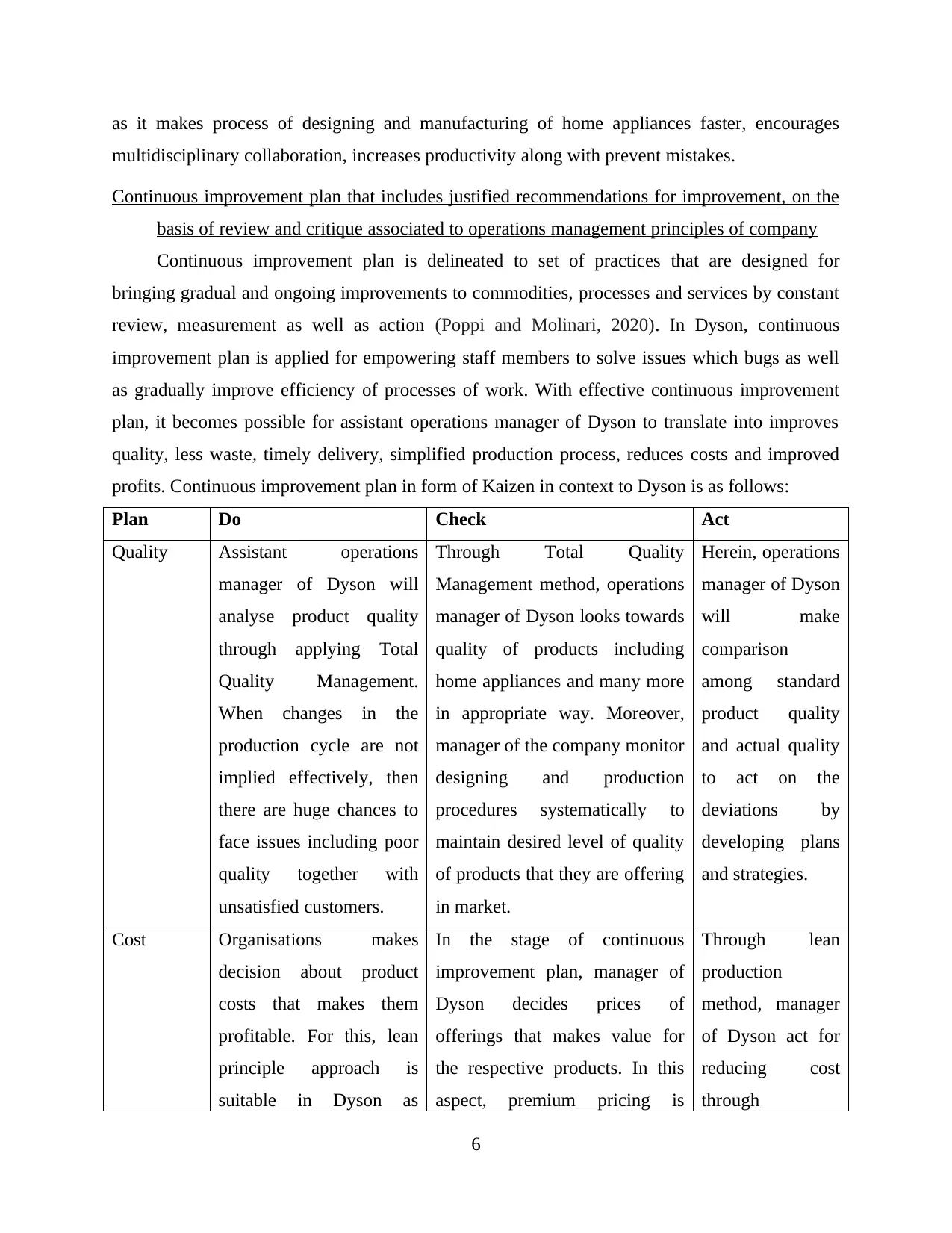
as it makes process of designing and manufacturing of home appliances faster, encourages
multidisciplinary collaboration, increases productivity along with prevent mistakes.
Continuous improvement plan that includes justified recommendations for improvement, on the
basis of review and critique associated to operations management principles of company
Continuous improvement plan is delineated to set of practices that are designed for
bringing gradual and ongoing improvements to commodities, processes and services by constant
review, measurement as well as action (Poppi and Molinari, 2020). In Dyson, continuous
improvement plan is applied for empowering staff members to solve issues which bugs as well
as gradually improve efficiency of processes of work. With effective continuous improvement
plan, it becomes possible for assistant operations manager of Dyson to translate into improves
quality, less waste, timely delivery, simplified production process, reduces costs and improved
profits. Continuous improvement plan in form of Kaizen in context to Dyson is as follows:
Plan Do Check Act
Quality Assistant operations
manager of Dyson will
analyse product quality
through applying Total
Quality Management.
When changes in the
production cycle are not
implied effectively, then
there are huge chances to
face issues including poor
quality together with
unsatisfied customers.
Through Total Quality
Management method, operations
manager of Dyson looks towards
quality of products including
home appliances and many more
in appropriate way. Moreover,
manager of the company monitor
designing and production
procedures systematically to
maintain desired level of quality
of products that they are offering
in market.
Herein, operations
manager of Dyson
will make
comparison
among standard
product quality
and actual quality
to act on the
deviations by
developing plans
and strategies.
Cost Organisations makes
decision about product
costs that makes them
profitable. For this, lean
principle approach is
suitable in Dyson as
In the stage of continuous
improvement plan, manager of
Dyson decides prices of
offerings that makes value for
the respective products. In this
aspect, premium pricing is
Through lean
production
method, manager
of Dyson act for
reducing cost
through
6
multidisciplinary collaboration, increases productivity along with prevent mistakes.
Continuous improvement plan that includes justified recommendations for improvement, on the
basis of review and critique associated to operations management principles of company
Continuous improvement plan is delineated to set of practices that are designed for
bringing gradual and ongoing improvements to commodities, processes and services by constant
review, measurement as well as action (Poppi and Molinari, 2020). In Dyson, continuous
improvement plan is applied for empowering staff members to solve issues which bugs as well
as gradually improve efficiency of processes of work. With effective continuous improvement
plan, it becomes possible for assistant operations manager of Dyson to translate into improves
quality, less waste, timely delivery, simplified production process, reduces costs and improved
profits. Continuous improvement plan in form of Kaizen in context to Dyson is as follows:
Plan Do Check Act
Quality Assistant operations
manager of Dyson will
analyse product quality
through applying Total
Quality Management.
When changes in the
production cycle are not
implied effectively, then
there are huge chances to
face issues including poor
quality together with
unsatisfied customers.
Through Total Quality
Management method, operations
manager of Dyson looks towards
quality of products including
home appliances and many more
in appropriate way. Moreover,
manager of the company monitor
designing and production
procedures systematically to
maintain desired level of quality
of products that they are offering
in market.
Herein, operations
manager of Dyson
will make
comparison
among standard
product quality
and actual quality
to act on the
deviations by
developing plans
and strategies.
Cost Organisations makes
decision about product
costs that makes them
profitable. For this, lean
principle approach is
suitable in Dyson as
In the stage of continuous
improvement plan, manager of
Dyson decides prices of
offerings that makes value for
the respective products. In this
aspect, premium pricing is
Through lean
production
method, manager
of Dyson act for
reducing cost
through
6
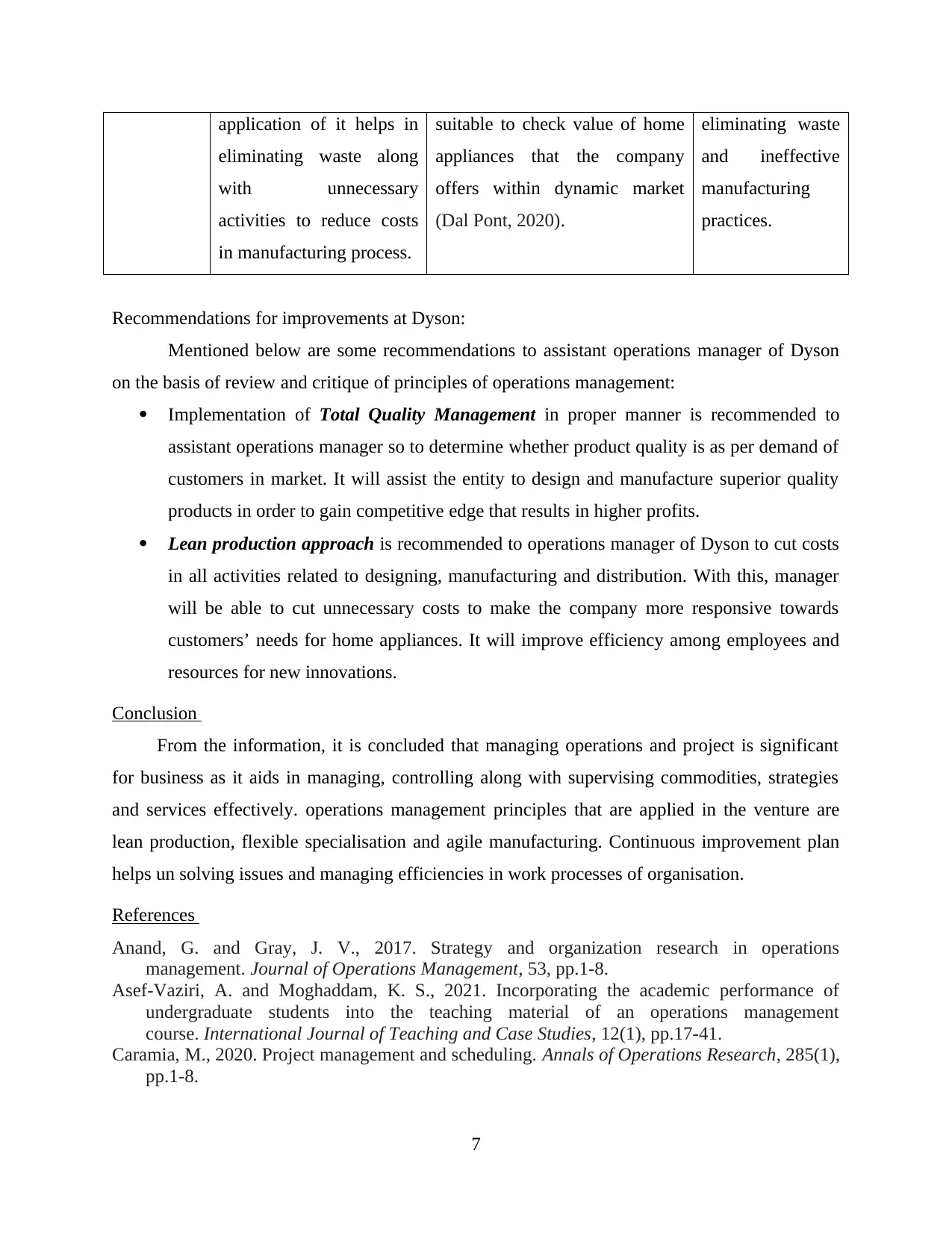
application of it helps in
eliminating waste along
with unnecessary
activities to reduce costs
in manufacturing process.
suitable to check value of home
appliances that the company
offers within dynamic market
(Dal Pont, 2020).
eliminating waste
and ineffective
manufacturing
practices.
Recommendations for improvements at Dyson:
Mentioned below are some recommendations to assistant operations manager of Dyson
on the basis of review and critique of principles of operations management:
Implementation of Total Quality Management in proper manner is recommended to
assistant operations manager so to determine whether product quality is as per demand of
customers in market. It will assist the entity to design and manufacture superior quality
products in order to gain competitive edge that results in higher profits.
Lean production approach is recommended to operations manager of Dyson to cut costs
in all activities related to designing, manufacturing and distribution. With this, manager
will be able to cut unnecessary costs to make the company more responsive towards
customers’ needs for home appliances. It will improve efficiency among employees and
resources for new innovations.
Conclusion
From the information, it is concluded that managing operations and project is significant
for business as it aids in managing, controlling along with supervising commodities, strategies
and services effectively. operations management principles that are applied in the venture are
lean production, flexible specialisation and agile manufacturing. Continuous improvement plan
helps un solving issues and managing efficiencies in work processes of organisation.
References
Anand, G. and Gray, J. V., 2017. Strategy and organization research in operations
management. Journal of Operations Management, 53, pp.1-8.
Asef-Vaziri, A. and Moghaddam, K. S., 2021. Incorporating the academic performance of
undergraduate students into the teaching material of an operations management
course. International Journal of Teaching and Case Studies, 12(1), pp.17-41.
Caramia, M., 2020. Project management and scheduling. Annals of Operations Research, 285(1),
pp.1-8.
7
eliminating waste along
with unnecessary
activities to reduce costs
in manufacturing process.
suitable to check value of home
appliances that the company
offers within dynamic market
(Dal Pont, 2020).
eliminating waste
and ineffective
manufacturing
practices.
Recommendations for improvements at Dyson:
Mentioned below are some recommendations to assistant operations manager of Dyson
on the basis of review and critique of principles of operations management:
Implementation of Total Quality Management in proper manner is recommended to
assistant operations manager so to determine whether product quality is as per demand of
customers in market. It will assist the entity to design and manufacture superior quality
products in order to gain competitive edge that results in higher profits.
Lean production approach is recommended to operations manager of Dyson to cut costs
in all activities related to designing, manufacturing and distribution. With this, manager
will be able to cut unnecessary costs to make the company more responsive towards
customers’ needs for home appliances. It will improve efficiency among employees and
resources for new innovations.
Conclusion
From the information, it is concluded that managing operations and project is significant
for business as it aids in managing, controlling along with supervising commodities, strategies
and services effectively. operations management principles that are applied in the venture are
lean production, flexible specialisation and agile manufacturing. Continuous improvement plan
helps un solving issues and managing efficiencies in work processes of organisation.
References
Anand, G. and Gray, J. V., 2017. Strategy and organization research in operations
management. Journal of Operations Management, 53, pp.1-8.
Asef-Vaziri, A. and Moghaddam, K. S., 2021. Incorporating the academic performance of
undergraduate students into the teaching material of an operations management
course. International Journal of Teaching and Case Studies, 12(1), pp.17-41.
Caramia, M., 2020. Project management and scheduling. Annals of Operations Research, 285(1),
pp.1-8.
7
Secure Best Marks with AI Grader
Need help grading? Try our AI Grader for instant feedback on your assignments.

Dal Pont, J. P., 2020. Operations. Process Industries 2: Digitalization, a New Key Driver for
Industrial Management, pp.109-128.
Essila, J. C. ed., 2019. Managing Operations Throughout Global Supply Chains. IGI Global.
Eyers, D. and Naim, M., 2019. Project Management for Effective Operations Management.
In Contemporary Operations and Logistics (pp. 11-27). Palgrave Macmillan, Cham.
Gajadhar, S. and Stomski, P., 2018, July. Integrating project management and systems
engineering to transition to remote operations. In Modeling, Systems Engineering, and
Project Management for Astronomy VIII (Vol. 10705, p. 107051B). International Society for
Optics and Photonics.
Haniff, A. and Caldwell, N., 2019. The 24th International Annual Conference: Inspiring
Operations Management. International Journal of Operations & Production Management.
Harrison, F. and Lock, D., 2017. Advanced project management: a structured approach.
Routledge.
Iden, J. and Bygstad, B., 2018. The social interaction of developers and IT operations staff in
software development projects. International Journal of Project Management, 36(3),
pp.485-497.
Kakade, R. G. and Bagga, P. S., 2021, March. Remote Operations: The New Norm.
In International Petroleum Technology Conference. OnePetro.
Kimmons, R. L. and Loweree, J. H., 2017. Project management: A reference for professionals.
Routledge.
Marsh, A. A. and McCannell, R., 2017. Program Management Approach to Stability Operations.
US Army Peacekeeping and Stability Operations Institute.
Poppi, S. and Molinari, E., 2020, December. A kanban approach for the Sardinia Radio
Telescope operations. In Observatory Operations: Strategies, Processes, and Systems
VIII (Vol. 11449, p. 114490W). International Society for Optics and Photonics.
Online:
Dyson. 2021. [Online]. Available through: < https://www.dyson.co.uk/en>
8
Industrial Management, pp.109-128.
Essila, J. C. ed., 2019. Managing Operations Throughout Global Supply Chains. IGI Global.
Eyers, D. and Naim, M., 2019. Project Management for Effective Operations Management.
In Contemporary Operations and Logistics (pp. 11-27). Palgrave Macmillan, Cham.
Gajadhar, S. and Stomski, P., 2018, July. Integrating project management and systems
engineering to transition to remote operations. In Modeling, Systems Engineering, and
Project Management for Astronomy VIII (Vol. 10705, p. 107051B). International Society for
Optics and Photonics.
Haniff, A. and Caldwell, N., 2019. The 24th International Annual Conference: Inspiring
Operations Management. International Journal of Operations & Production Management.
Harrison, F. and Lock, D., 2017. Advanced project management: a structured approach.
Routledge.
Iden, J. and Bygstad, B., 2018. The social interaction of developers and IT operations staff in
software development projects. International Journal of Project Management, 36(3),
pp.485-497.
Kakade, R. G. and Bagga, P. S., 2021, March. Remote Operations: The New Norm.
In International Petroleum Technology Conference. OnePetro.
Kimmons, R. L. and Loweree, J. H., 2017. Project management: A reference for professionals.
Routledge.
Marsh, A. A. and McCannell, R., 2017. Program Management Approach to Stability Operations.
US Army Peacekeeping and Stability Operations Institute.
Poppi, S. and Molinari, E., 2020, December. A kanban approach for the Sardinia Radio
Telescope operations. In Observatory Operations: Strategies, Processes, and Systems
VIII (Vol. 11449, p. 114490W). International Society for Optics and Photonics.
Online:
Dyson. 2021. [Online]. Available through: < https://www.dyson.co.uk/en>
8

PART 2
Project Title
The project title for the portfolio is “On site catering to Siemens for provide heathy food to
staff”.
Overview of case study
On site catering for providing food to staff is a project that will bring well organised and
healthy food to staff of large manufacturing company that is Siemens that is based on Midlands
having around 1250 employees on work site (Siemens, 2021). In this, Project and Programme
Office is responsible to deliver change programme in the company. It is an in-house project
having objectives to reduce movement of employees from premises in lunch breaks that is
existing creating congestion issues in local area and helping manpower to develop a healthy
lifestyle that the venture believes a part of corporate social responsibility together with reduce
employee absenteeism. In the project, main focus is towards getting catered from somewhere.
Explanation of each stages of PLC which applies to selected project, including supporting
documentation for each stage
Project life cycle is four step framework planned for guiding project manager to complete
activities of projects successfully (Geertsen, 2020). Key purpose of project plan is to gain
understanding about stages to manage a project. In context to project of on-site catering to
Siemens, explanation of all project life cycle stages is underneath:
Project initiation:
The stage comprises of details including business needs, key stakeholders and other
participants, scope, goals and some relevant information about project. It is the project in which a
project starts. It provides overview of a project together with strategies that are required for
attaining desired results. In aspect to project of on-site catering to Siemens, some of items or
documents are as follows:
Goal: Goal of the project that is On-site catering to Siemens is to provide healthy food to
employees at work site of company.
Scope: In aspect to project of on-site catering to Siemens, scope is to provide healthy
food to employees through getting catered from somewhere.
9
Project Title
The project title for the portfolio is “On site catering to Siemens for provide heathy food to
staff”.
Overview of case study
On site catering for providing food to staff is a project that will bring well organised and
healthy food to staff of large manufacturing company that is Siemens that is based on Midlands
having around 1250 employees on work site (Siemens, 2021). In this, Project and Programme
Office is responsible to deliver change programme in the company. It is an in-house project
having objectives to reduce movement of employees from premises in lunch breaks that is
existing creating congestion issues in local area and helping manpower to develop a healthy
lifestyle that the venture believes a part of corporate social responsibility together with reduce
employee absenteeism. In the project, main focus is towards getting catered from somewhere.
Explanation of each stages of PLC which applies to selected project, including supporting
documentation for each stage
Project life cycle is four step framework planned for guiding project manager to complete
activities of projects successfully (Geertsen, 2020). Key purpose of project plan is to gain
understanding about stages to manage a project. In context to project of on-site catering to
Siemens, explanation of all project life cycle stages is underneath:
Project initiation:
The stage comprises of details including business needs, key stakeholders and other
participants, scope, goals and some relevant information about project. It is the project in which a
project starts. It provides overview of a project together with strategies that are required for
attaining desired results. In aspect to project of on-site catering to Siemens, some of items or
documents are as follows:
Goal: Goal of the project that is On-site catering to Siemens is to provide healthy food to
employees at work site of company.
Scope: In aspect to project of on-site catering to Siemens, scope is to provide healthy
food to employees through getting catered from somewhere.
9
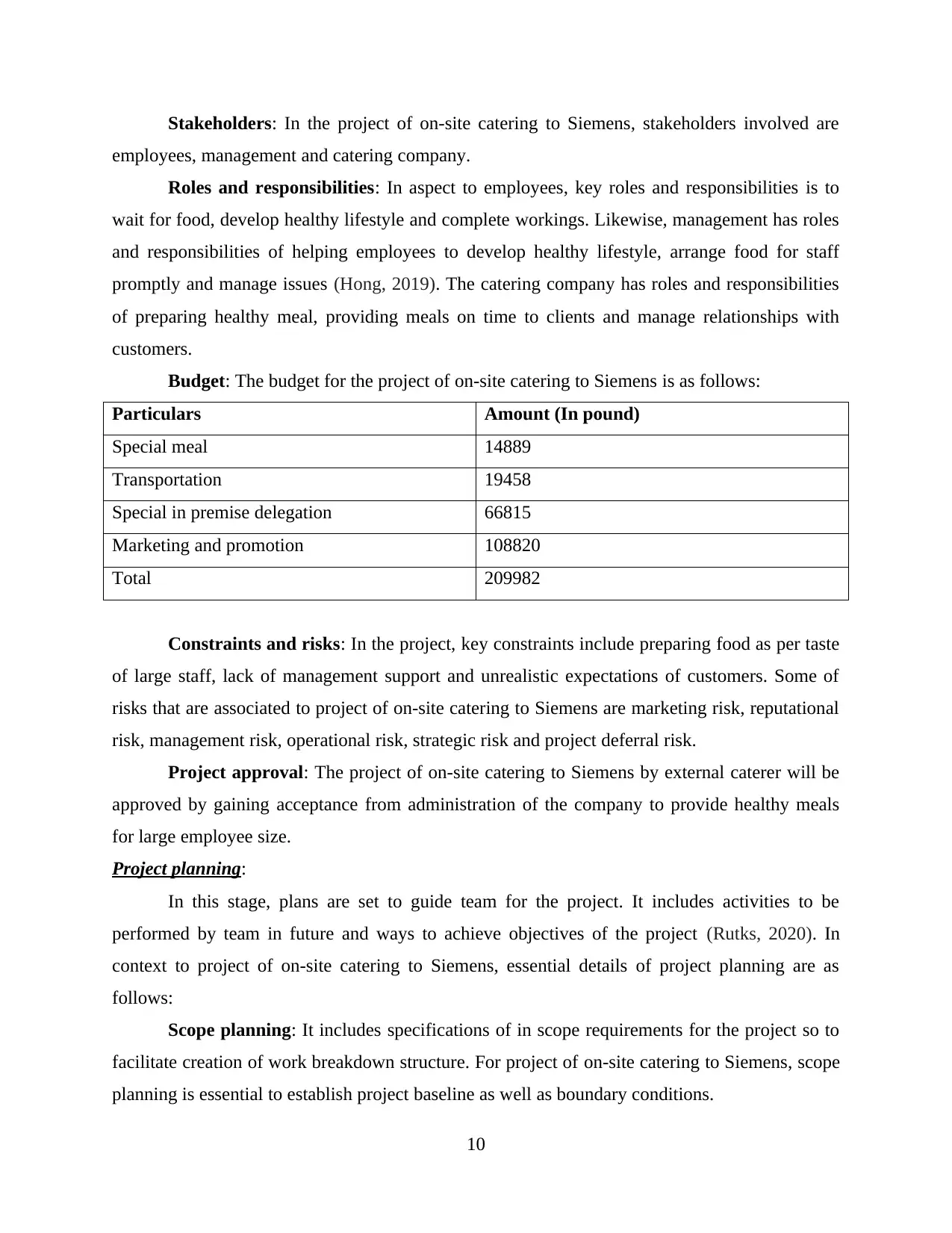
Stakeholders: In the project of on-site catering to Siemens, stakeholders involved are
employees, management and catering company.
Roles and responsibilities: In aspect to employees, key roles and responsibilities is to
wait for food, develop healthy lifestyle and complete workings. Likewise, management has roles
and responsibilities of helping employees to develop healthy lifestyle, arrange food for staff
promptly and manage issues (Hong, 2019). The catering company has roles and responsibilities
of preparing healthy meal, providing meals on time to clients and manage relationships with
customers.
Budget: The budget for the project of on-site catering to Siemens is as follows:
Particulars Amount (In pound)
Special meal 14889
Transportation 19458
Special in premise delegation 66815
Marketing and promotion 108820
Total 209982
Constraints and risks: In the project, key constraints include preparing food as per taste
of large staff, lack of management support and unrealistic expectations of customers. Some of
risks that are associated to project of on-site catering to Siemens are marketing risk, reputational
risk, management risk, operational risk, strategic risk and project deferral risk.
Project approval: The project of on-site catering to Siemens by external caterer will be
approved by gaining acceptance from administration of the company to provide healthy meals
for large employee size.
Project planning:
In this stage, plans are set to guide team for the project. It includes activities to be
performed by team in future and ways to achieve objectives of the project (Rutks, 2020). In
context to project of on-site catering to Siemens, essential details of project planning are as
follows:
Scope planning: It includes specifications of in scope requirements for the project so to
facilitate creation of work breakdown structure. For project of on-site catering to Siemens, scope
planning is essential to establish project baseline as well as boundary conditions.
10
employees, management and catering company.
Roles and responsibilities: In aspect to employees, key roles and responsibilities is to
wait for food, develop healthy lifestyle and complete workings. Likewise, management has roles
and responsibilities of helping employees to develop healthy lifestyle, arrange food for staff
promptly and manage issues (Hong, 2019). The catering company has roles and responsibilities
of preparing healthy meal, providing meals on time to clients and manage relationships with
customers.
Budget: The budget for the project of on-site catering to Siemens is as follows:
Particulars Amount (In pound)
Special meal 14889
Transportation 19458
Special in premise delegation 66815
Marketing and promotion 108820
Total 209982
Constraints and risks: In the project, key constraints include preparing food as per taste
of large staff, lack of management support and unrealistic expectations of customers. Some of
risks that are associated to project of on-site catering to Siemens are marketing risk, reputational
risk, management risk, operational risk, strategic risk and project deferral risk.
Project approval: The project of on-site catering to Siemens by external caterer will be
approved by gaining acceptance from administration of the company to provide healthy meals
for large employee size.
Project planning:
In this stage, plans are set to guide team for the project. It includes activities to be
performed by team in future and ways to achieve objectives of the project (Rutks, 2020). In
context to project of on-site catering to Siemens, essential details of project planning are as
follows:
Scope planning: It includes specifications of in scope requirements for the project so to
facilitate creation of work breakdown structure. For project of on-site catering to Siemens, scope
planning is essential to establish project baseline as well as boundary conditions.
10
Paraphrase This Document
Need a fresh take? Get an instant paraphrase of this document with our AI Paraphraser
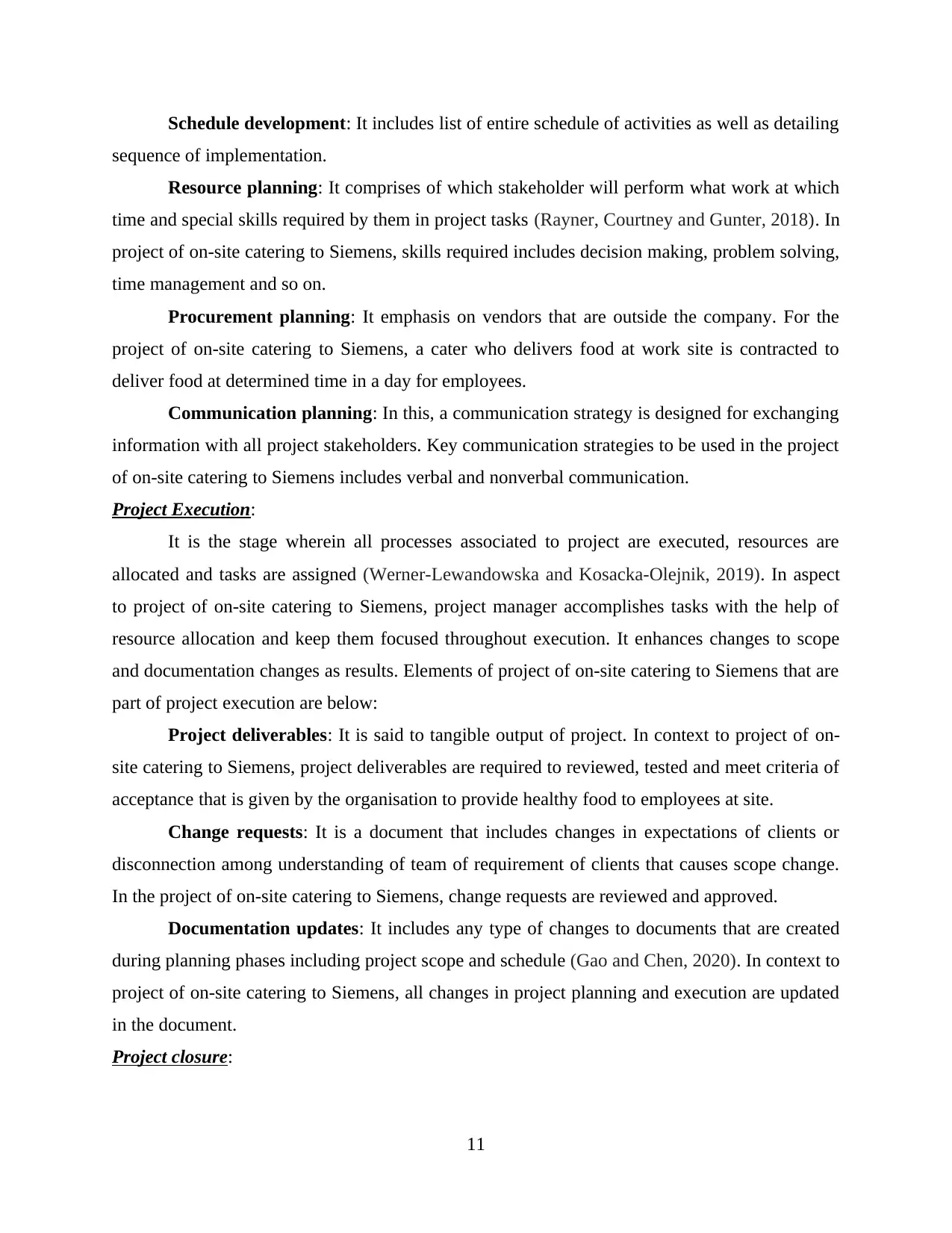
Schedule development: It includes list of entire schedule of activities as well as detailing
sequence of implementation.
Resource planning: It comprises of which stakeholder will perform what work at which
time and special skills required by them in project tasks (Rayner, Courtney and Gunter, 2018). In
project of on-site catering to Siemens, skills required includes decision making, problem solving,
time management and so on.
Procurement planning: It emphasis on vendors that are outside the company. For the
project of on-site catering to Siemens, a cater who delivers food at work site is contracted to
deliver food at determined time in a day for employees.
Communication planning: In this, a communication strategy is designed for exchanging
information with all project stakeholders. Key communication strategies to be used in the project
of on-site catering to Siemens includes verbal and nonverbal communication.
Project Execution:
It is the stage wherein all processes associated to project are executed, resources are
allocated and tasks are assigned (Werner-Lewandowska and Kosacka-Olejnik, 2019). In aspect
to project of on-site catering to Siemens, project manager accomplishes tasks with the help of
resource allocation and keep them focused throughout execution. It enhances changes to scope
and documentation changes as results. Elements of project of on-site catering to Siemens that are
part of project execution are below:
Project deliverables: It is said to tangible output of project. In context to project of on-
site catering to Siemens, project deliverables are required to reviewed, tested and meet criteria of
acceptance that is given by the organisation to provide healthy food to employees at site.
Change requests: It is a document that includes changes in expectations of clients or
disconnection among understanding of team of requirement of clients that causes scope change.
In the project of on-site catering to Siemens, change requests are reviewed and approved.
Documentation updates: It includes any type of changes to documents that are created
during planning phases including project scope and schedule (Gao and Chen, 2020). In context to
project of on-site catering to Siemens, all changes in project planning and execution are updated
in the document.
Project closure:
11
sequence of implementation.
Resource planning: It comprises of which stakeholder will perform what work at which
time and special skills required by them in project tasks (Rayner, Courtney and Gunter, 2018). In
project of on-site catering to Siemens, skills required includes decision making, problem solving,
time management and so on.
Procurement planning: It emphasis on vendors that are outside the company. For the
project of on-site catering to Siemens, a cater who delivers food at work site is contracted to
deliver food at determined time in a day for employees.
Communication planning: In this, a communication strategy is designed for exchanging
information with all project stakeholders. Key communication strategies to be used in the project
of on-site catering to Siemens includes verbal and nonverbal communication.
Project Execution:
It is the stage wherein all processes associated to project are executed, resources are
allocated and tasks are assigned (Werner-Lewandowska and Kosacka-Olejnik, 2019). In aspect
to project of on-site catering to Siemens, project manager accomplishes tasks with the help of
resource allocation and keep them focused throughout execution. It enhances changes to scope
and documentation changes as results. Elements of project of on-site catering to Siemens that are
part of project execution are below:
Project deliverables: It is said to tangible output of project. In context to project of on-
site catering to Siemens, project deliverables are required to reviewed, tested and meet criteria of
acceptance that is given by the organisation to provide healthy food to employees at site.
Change requests: It is a document that includes changes in expectations of clients or
disconnection among understanding of team of requirement of clients that causes scope change.
In the project of on-site catering to Siemens, change requests are reviewed and approved.
Documentation updates: It includes any type of changes to documents that are created
during planning phases including project scope and schedule (Gao and Chen, 2020). In context to
project of on-site catering to Siemens, all changes in project planning and execution are updated
in the document.
Project closure:
11
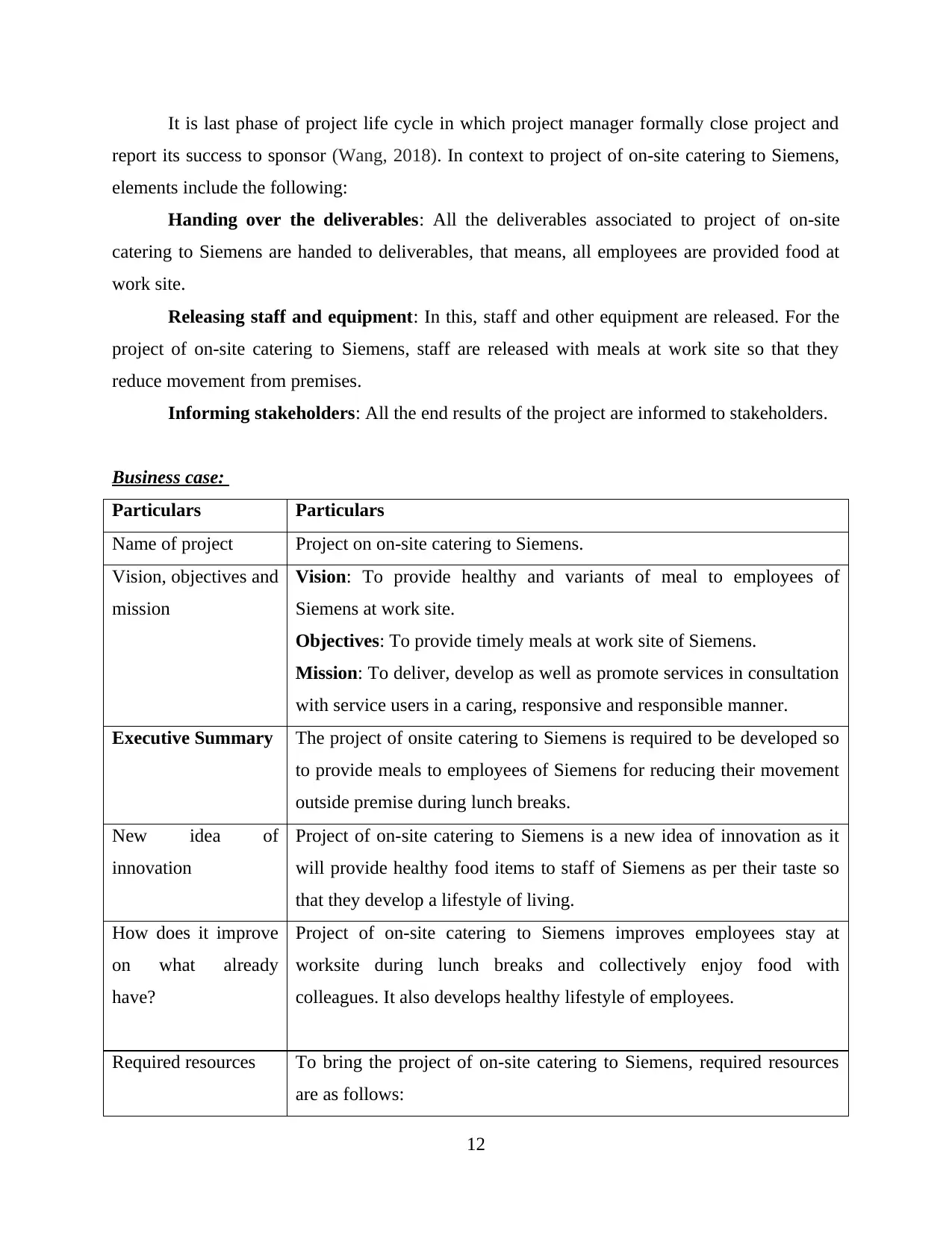
It is last phase of project life cycle in which project manager formally close project and
report its success to sponsor (Wang, 2018). In context to project of on-site catering to Siemens,
elements include the following:
Handing over the deliverables: All the deliverables associated to project of on-site
catering to Siemens are handed to deliverables, that means, all employees are provided food at
work site.
Releasing staff and equipment: In this, staff and other equipment are released. For the
project of on-site catering to Siemens, staff are released with meals at work site so that they
reduce movement from premises.
Informing stakeholders: All the end results of the project are informed to stakeholders.
Business case:
Particulars Particulars
Name of project Project on on-site catering to Siemens.
Vision, objectives and
mission
Vision: To provide healthy and variants of meal to employees of
Siemens at work site.
Objectives: To provide timely meals at work site of Siemens.
Mission: To deliver, develop as well as promote services in consultation
with service users in a caring, responsive and responsible manner.
Executive Summary The project of onsite catering to Siemens is required to be developed so
to provide meals to employees of Siemens for reducing their movement
outside premise during lunch breaks.
New idea of
innovation
Project of on-site catering to Siemens is a new idea of innovation as it
will provide healthy food items to staff of Siemens as per their taste so
that they develop a lifestyle of living.
How does it improve
on what already
have?
Project of on-site catering to Siemens improves employees stay at
worksite during lunch breaks and collectively enjoy food with
colleagues. It also develops healthy lifestyle of employees.
Required resources To bring the project of on-site catering to Siemens, required resources
are as follows:
12
report its success to sponsor (Wang, 2018). In context to project of on-site catering to Siemens,
elements include the following:
Handing over the deliverables: All the deliverables associated to project of on-site
catering to Siemens are handed to deliverables, that means, all employees are provided food at
work site.
Releasing staff and equipment: In this, staff and other equipment are released. For the
project of on-site catering to Siemens, staff are released with meals at work site so that they
reduce movement from premises.
Informing stakeholders: All the end results of the project are informed to stakeholders.
Business case:
Particulars Particulars
Name of project Project on on-site catering to Siemens.
Vision, objectives and
mission
Vision: To provide healthy and variants of meal to employees of
Siemens at work site.
Objectives: To provide timely meals at work site of Siemens.
Mission: To deliver, develop as well as promote services in consultation
with service users in a caring, responsive and responsible manner.
Executive Summary The project of onsite catering to Siemens is required to be developed so
to provide meals to employees of Siemens for reducing their movement
outside premise during lunch breaks.
New idea of
innovation
Project of on-site catering to Siemens is a new idea of innovation as it
will provide healthy food items to staff of Siemens as per their taste so
that they develop a lifestyle of living.
How does it improve
on what already
have?
Project of on-site catering to Siemens improves employees stay at
worksite during lunch breaks and collectively enjoy food with
colleagues. It also develops healthy lifestyle of employees.
Required resources To bring the project of on-site catering to Siemens, required resources
are as follows:
12
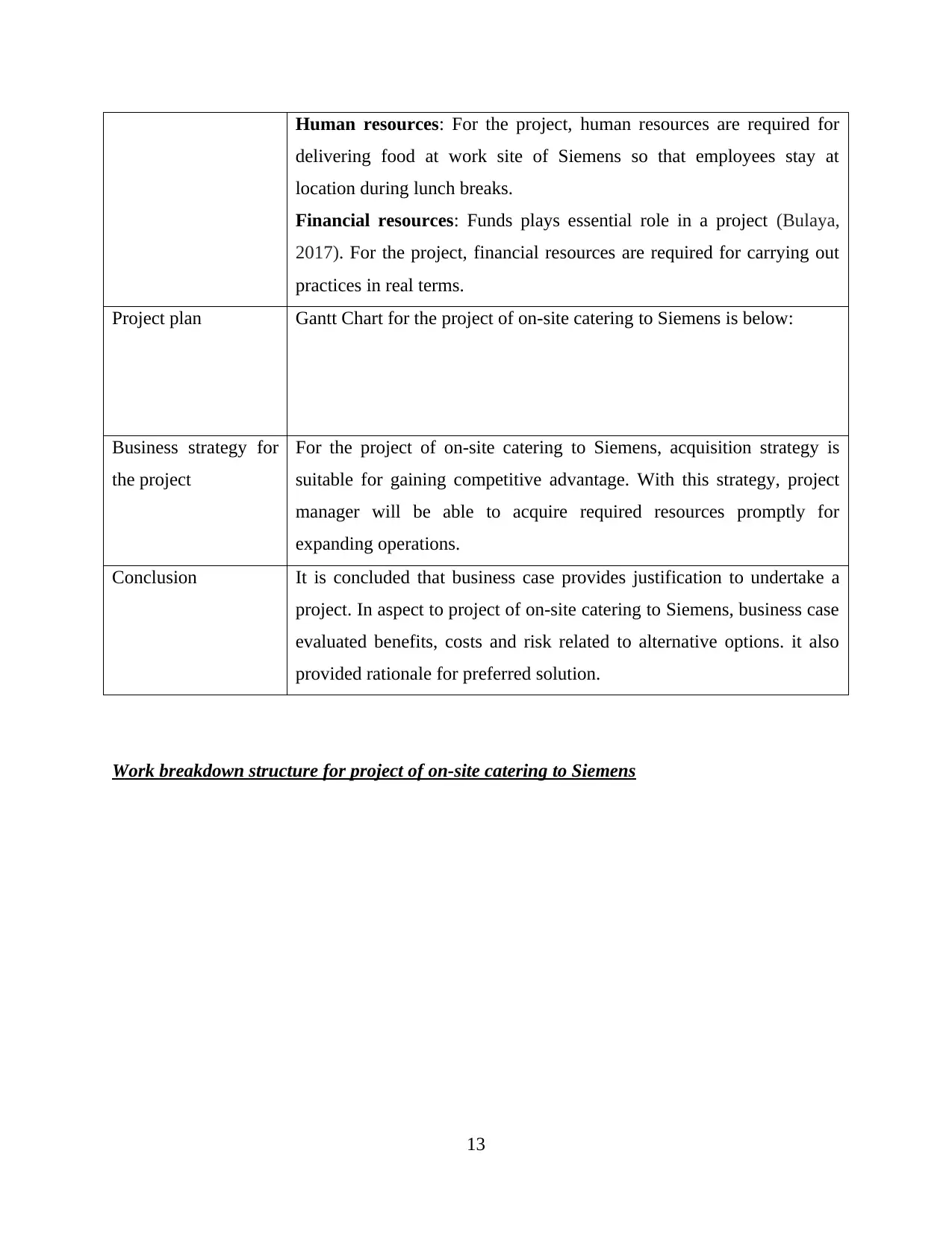
Human resources: For the project, human resources are required for
delivering food at work site of Siemens so that employees stay at
location during lunch breaks.
Financial resources: Funds plays essential role in a project (Bulaya,
2017). For the project, financial resources are required for carrying out
practices in real terms.
Project plan Gantt Chart for the project of on-site catering to Siemens is below:
Business strategy for
the project
For the project of on-site catering to Siemens, acquisition strategy is
suitable for gaining competitive advantage. With this strategy, project
manager will be able to acquire required resources promptly for
expanding operations.
Conclusion It is concluded that business case provides justification to undertake a
project. In aspect to project of on-site catering to Siemens, business case
evaluated benefits, costs and risk related to alternative options. it also
provided rationale for preferred solution.
Work breakdown structure for project of on-site catering to Siemens
13
delivering food at work site of Siemens so that employees stay at
location during lunch breaks.
Financial resources: Funds plays essential role in a project (Bulaya,
2017). For the project, financial resources are required for carrying out
practices in real terms.
Project plan Gantt Chart for the project of on-site catering to Siemens is below:
Business strategy for
the project
For the project of on-site catering to Siemens, acquisition strategy is
suitable for gaining competitive advantage. With this strategy, project
manager will be able to acquire required resources promptly for
expanding operations.
Conclusion It is concluded that business case provides justification to undertake a
project. In aspect to project of on-site catering to Siemens, business case
evaluated benefits, costs and risk related to alternative options. it also
provided rationale for preferred solution.
Work breakdown structure for project of on-site catering to Siemens
13
Secure Best Marks with AI Grader
Need help grading? Try our AI Grader for instant feedback on your assignments.
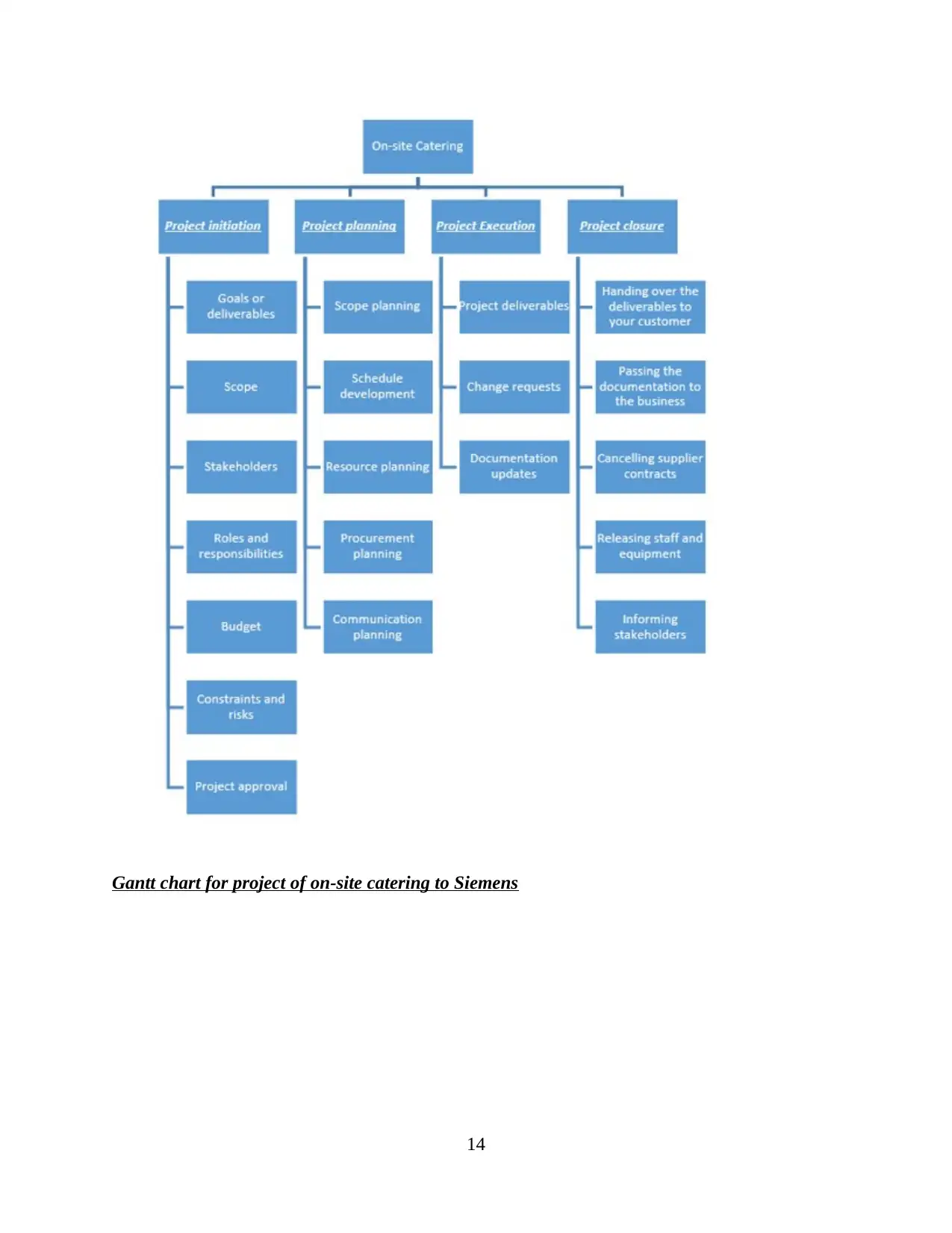
Gantt chart for project of on-site catering to Siemens
14
14
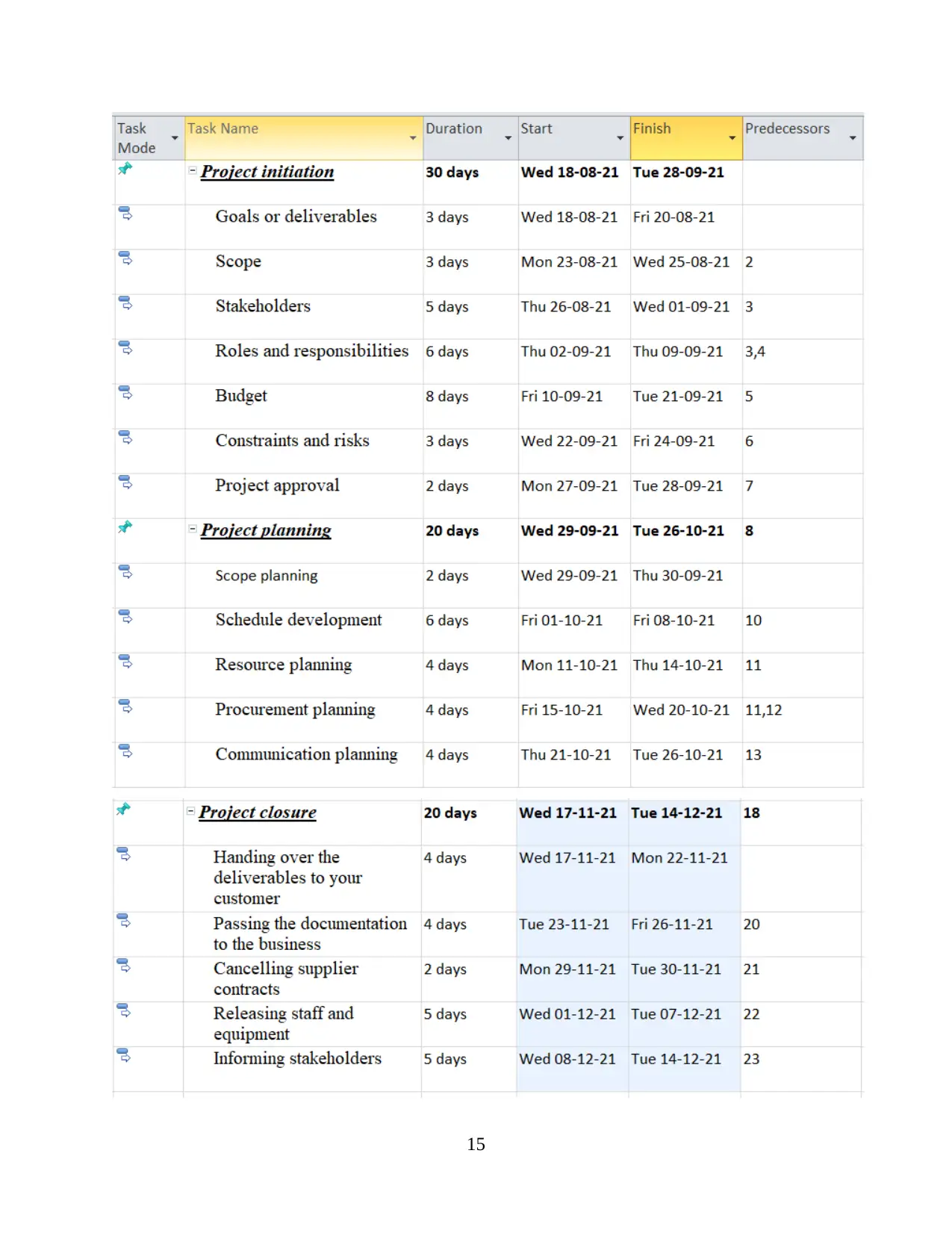
15
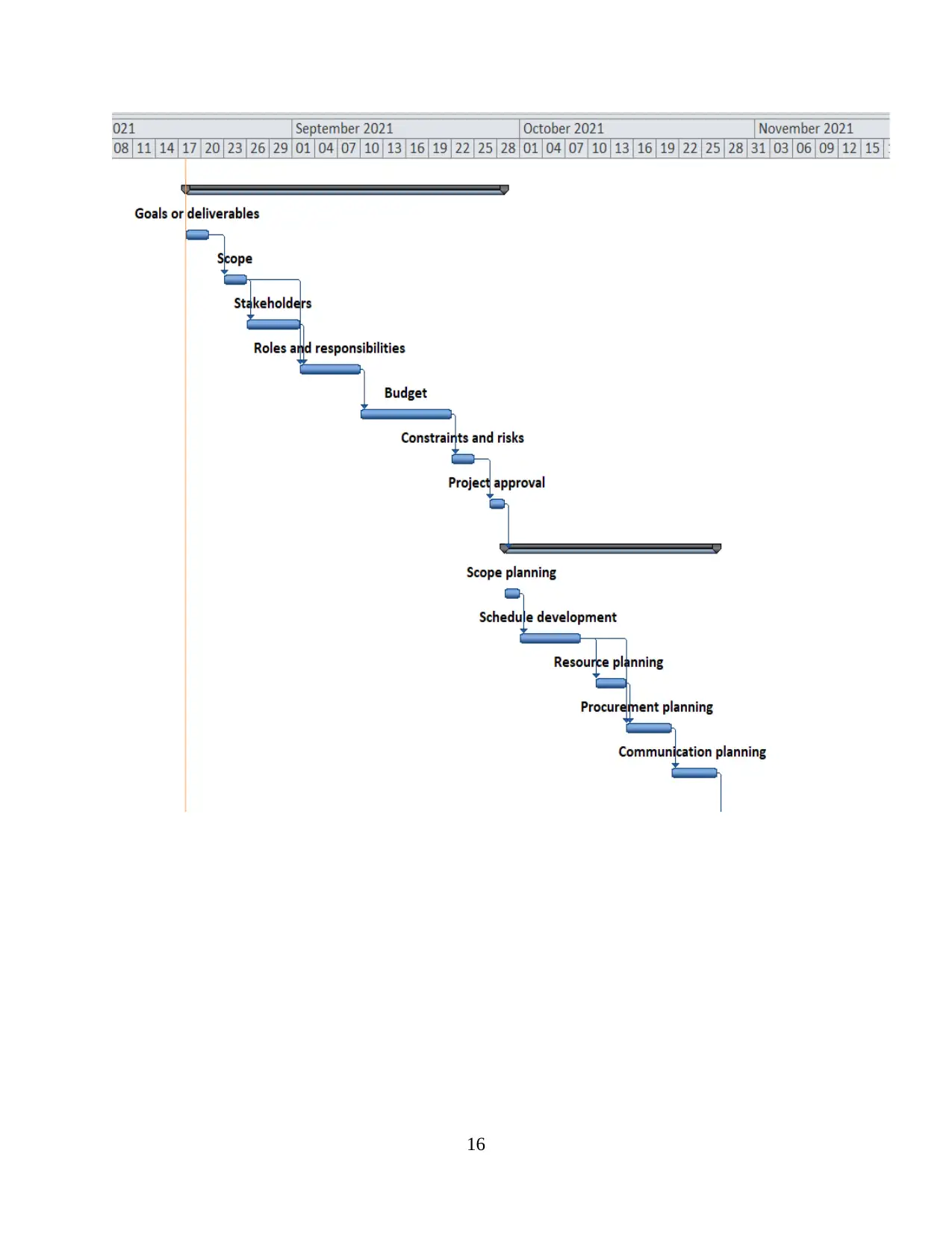
16
Paraphrase This Document
Need a fresh take? Get an instant paraphrase of this document with our AI Paraphraser
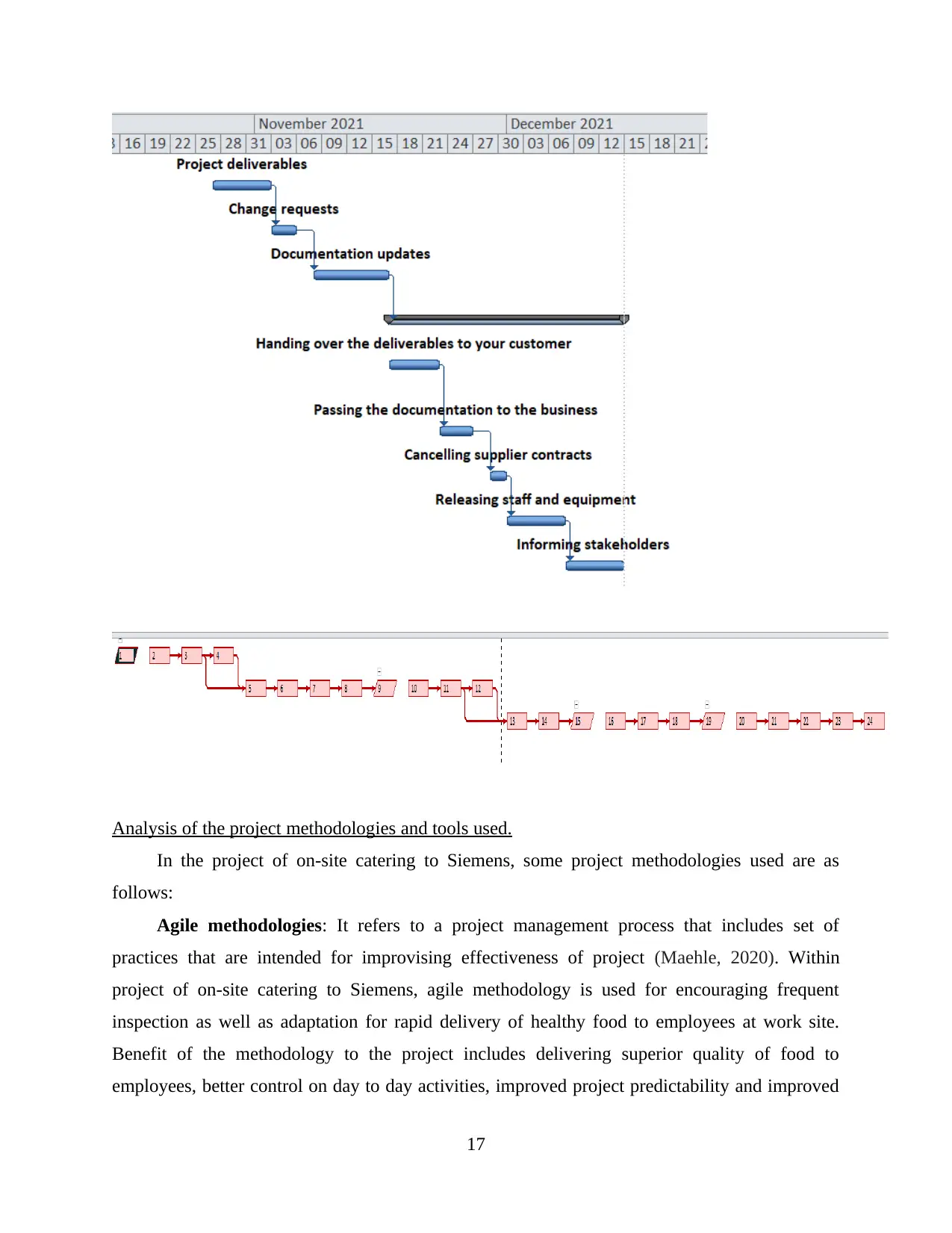
Analysis of the project methodologies and tools used.
In the project of on-site catering to Siemens, some project methodologies used are as
follows:
Agile methodologies: It refers to a project management process that includes set of
practices that are intended for improvising effectiveness of project (Maehle, 2020). Within
project of on-site catering to Siemens, agile methodology is used for encouraging frequent
inspection as well as adaptation for rapid delivery of healthy food to employees at work site.
Benefit of the methodology to the project includes delivering superior quality of food to
employees, better control on day to day activities, improved project predictability and improved
17
In the project of on-site catering to Siemens, some project methodologies used are as
follows:
Agile methodologies: It refers to a project management process that includes set of
practices that are intended for improvising effectiveness of project (Maehle, 2020). Within
project of on-site catering to Siemens, agile methodology is used for encouraging frequent
inspection as well as adaptation for rapid delivery of healthy food to employees at work site.
Benefit of the methodology to the project includes delivering superior quality of food to
employees, better control on day to day activities, improved project predictability and improved
17
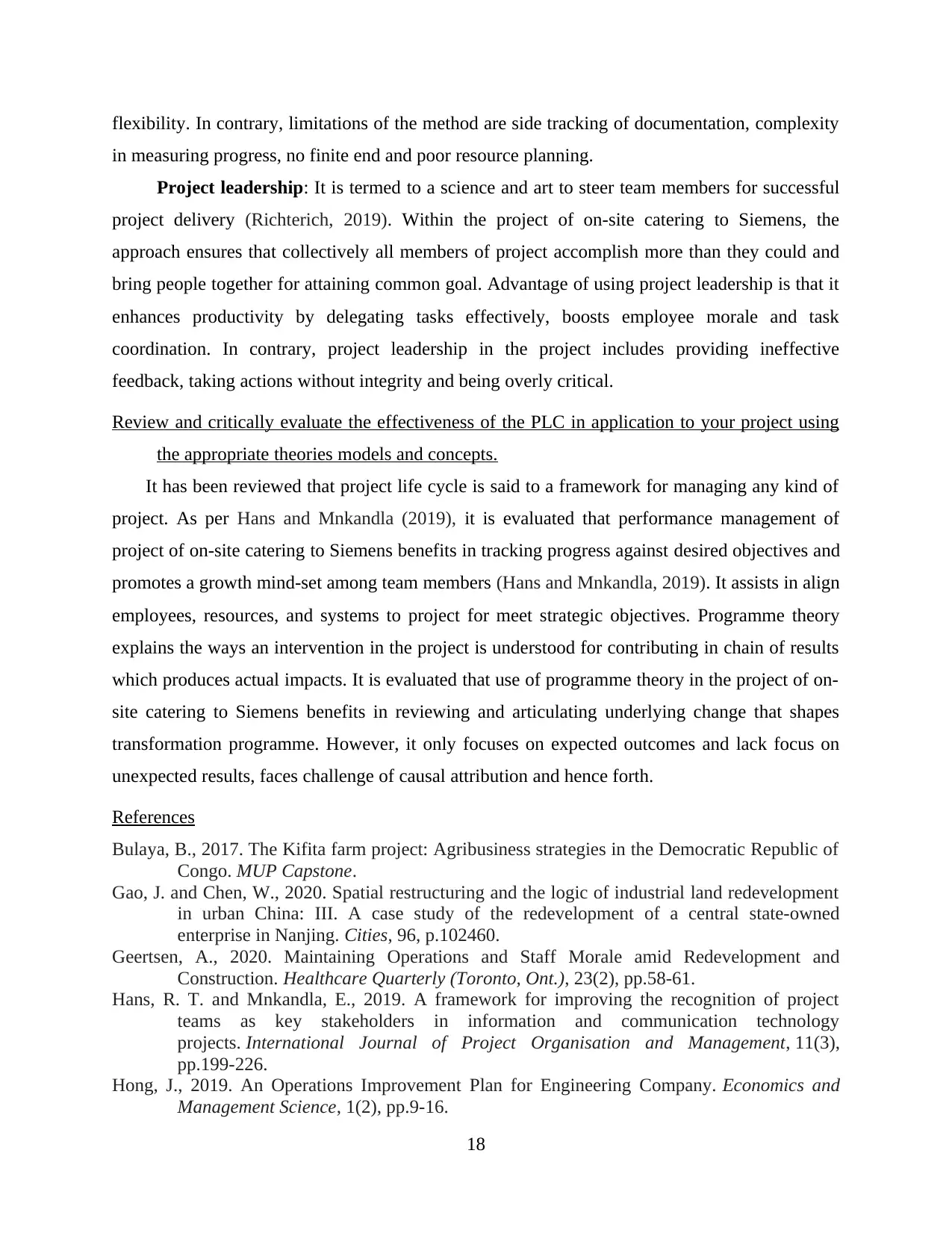
flexibility. In contrary, limitations of the method are side tracking of documentation, complexity
in measuring progress, no finite end and poor resource planning.
Project leadership: It is termed to a science and art to steer team members for successful
project delivery (Richterich, 2019). Within the project of on-site catering to Siemens, the
approach ensures that collectively all members of project accomplish more than they could and
bring people together for attaining common goal. Advantage of using project leadership is that it
enhances productivity by delegating tasks effectively, boosts employee morale and task
coordination. In contrary, project leadership in the project includes providing ineffective
feedback, taking actions without integrity and being overly critical.
Review and critically evaluate the effectiveness of the PLC in application to your project using
the appropriate theories models and concepts.
It has been reviewed that project life cycle is said to a framework for managing any kind of
project. As per Hans and Mnkandla (2019), it is evaluated that performance management of
project of on-site catering to Siemens benefits in tracking progress against desired objectives and
promotes a growth mind-set among team members (Hans and Mnkandla, 2019). It assists in align
employees, resources, and systems to project for meet strategic objectives. Programme theory
explains the ways an intervention in the project is understood for contributing in chain of results
which produces actual impacts. It is evaluated that use of programme theory in the project of on-
site catering to Siemens benefits in reviewing and articulating underlying change that shapes
transformation programme. However, it only focuses on expected outcomes and lack focus on
unexpected results, faces challenge of causal attribution and hence forth.
References
Bulaya, B., 2017. The Kifita farm project: Agribusiness strategies in the Democratic Republic of
Congo. MUP Capstone.
Gao, J. and Chen, W., 2020. Spatial restructuring and the logic of industrial land redevelopment
in urban China: III. A case study of the redevelopment of a central state-owned
enterprise in Nanjing. Cities, 96, p.102460.
Geertsen, A., 2020. Maintaining Operations and Staff Morale amid Redevelopment and
Construction. Healthcare Quarterly (Toronto, Ont.), 23(2), pp.58-61.
Hans, R. T. and Mnkandla, E., 2019. A framework for improving the recognition of project
teams as key stakeholders in information and communication technology
projects. International Journal of Project Organisation and Management, 11(3),
pp.199-226.
Hong, J., 2019. An Operations Improvement Plan for Engineering Company. Economics and
Management Science, 1(2), pp.9-16.
18
in measuring progress, no finite end and poor resource planning.
Project leadership: It is termed to a science and art to steer team members for successful
project delivery (Richterich, 2019). Within the project of on-site catering to Siemens, the
approach ensures that collectively all members of project accomplish more than they could and
bring people together for attaining common goal. Advantage of using project leadership is that it
enhances productivity by delegating tasks effectively, boosts employee morale and task
coordination. In contrary, project leadership in the project includes providing ineffective
feedback, taking actions without integrity and being overly critical.
Review and critically evaluate the effectiveness of the PLC in application to your project using
the appropriate theories models and concepts.
It has been reviewed that project life cycle is said to a framework for managing any kind of
project. As per Hans and Mnkandla (2019), it is evaluated that performance management of
project of on-site catering to Siemens benefits in tracking progress against desired objectives and
promotes a growth mind-set among team members (Hans and Mnkandla, 2019). It assists in align
employees, resources, and systems to project for meet strategic objectives. Programme theory
explains the ways an intervention in the project is understood for contributing in chain of results
which produces actual impacts. It is evaluated that use of programme theory in the project of on-
site catering to Siemens benefits in reviewing and articulating underlying change that shapes
transformation programme. However, it only focuses on expected outcomes and lack focus on
unexpected results, faces challenge of causal attribution and hence forth.
References
Bulaya, B., 2017. The Kifita farm project: Agribusiness strategies in the Democratic Republic of
Congo. MUP Capstone.
Gao, J. and Chen, W., 2020. Spatial restructuring and the logic of industrial land redevelopment
in urban China: III. A case study of the redevelopment of a central state-owned
enterprise in Nanjing. Cities, 96, p.102460.
Geertsen, A., 2020. Maintaining Operations and Staff Morale amid Redevelopment and
Construction. Healthcare Quarterly (Toronto, Ont.), 23(2), pp.58-61.
Hans, R. T. and Mnkandla, E., 2019. A framework for improving the recognition of project
teams as key stakeholders in information and communication technology
projects. International Journal of Project Organisation and Management, 11(3),
pp.199-226.
Hong, J., 2019. An Operations Improvement Plan for Engineering Company. Economics and
Management Science, 1(2), pp.9-16.
18
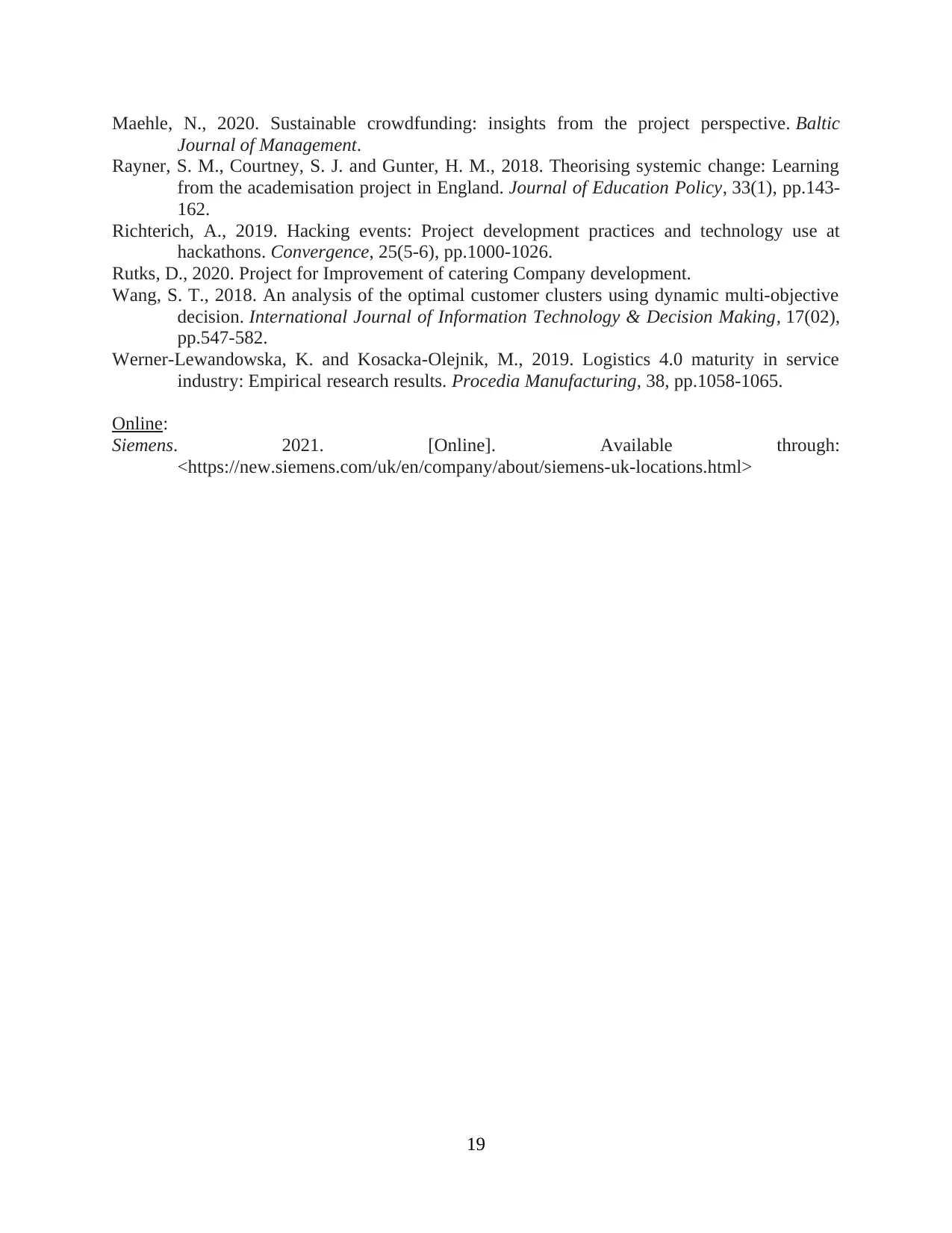
Maehle, N., 2020. Sustainable crowdfunding: insights from the project perspective. Baltic
Journal of Management.
Rayner, S. M., Courtney, S. J. and Gunter, H. M., 2018. Theorising systemic change: Learning
from the academisation project in England. Journal of Education Policy, 33(1), pp.143-
162.
Richterich, A., 2019. Hacking events: Project development practices and technology use at
hackathons. Convergence, 25(5-6), pp.1000-1026.
Rutks, D., 2020. Project for Improvement of catering Company development.
Wang, S. T., 2018. An analysis of the optimal customer clusters using dynamic multi-objective
decision. International Journal of Information Technology & Decision Making, 17(02),
pp.547-582.
Werner-Lewandowska, K. and Kosacka-Olejnik, M., 2019. Logistics 4.0 maturity in service
industry: Empirical research results. Procedia Manufacturing, 38, pp.1058-1065.
Online:
Siemens. 2021. [Online]. Available through:
<https://new.siemens.com/uk/en/company/about/siemens-uk-locations.html>
19
Journal of Management.
Rayner, S. M., Courtney, S. J. and Gunter, H. M., 2018. Theorising systemic change: Learning
from the academisation project in England. Journal of Education Policy, 33(1), pp.143-
162.
Richterich, A., 2019. Hacking events: Project development practices and technology use at
hackathons. Convergence, 25(5-6), pp.1000-1026.
Rutks, D., 2020. Project for Improvement of catering Company development.
Wang, S. T., 2018. An analysis of the optimal customer clusters using dynamic multi-objective
decision. International Journal of Information Technology & Decision Making, 17(02),
pp.547-582.
Werner-Lewandowska, K. and Kosacka-Olejnik, M., 2019. Logistics 4.0 maturity in service
industry: Empirical research results. Procedia Manufacturing, 38, pp.1058-1065.
Online:
Siemens. 2021. [Online]. Available through:
<https://new.siemens.com/uk/en/company/about/siemens-uk-locations.html>
19
1 out of 22
Related Documents
Your All-in-One AI-Powered Toolkit for Academic Success.
+13062052269
info@desklib.com
Available 24*7 on WhatsApp / Email
![[object Object]](/_next/static/media/star-bottom.7253800d.svg)
Unlock your academic potential
© 2024 | Zucol Services PVT LTD | All rights reserved.



